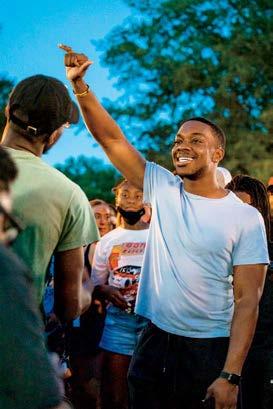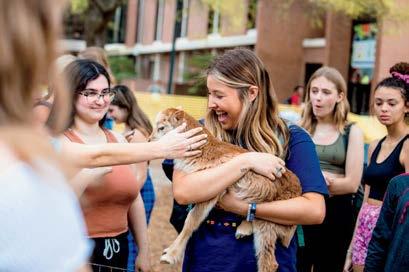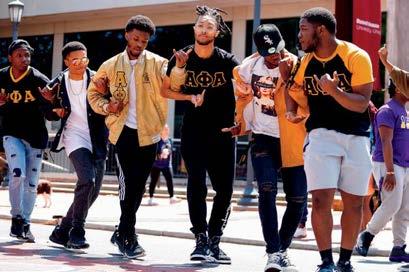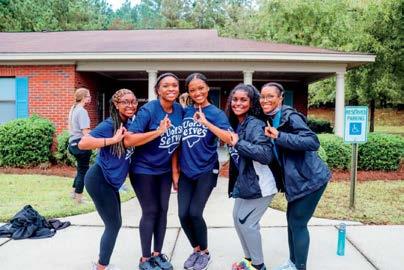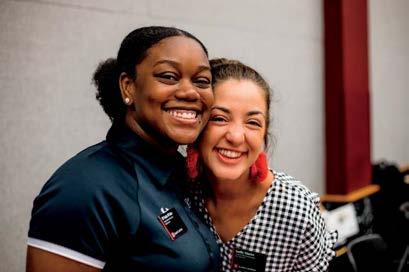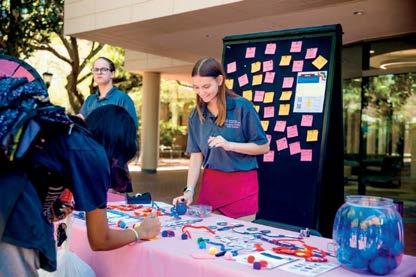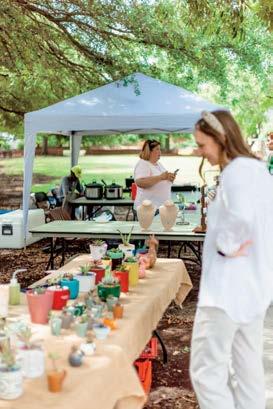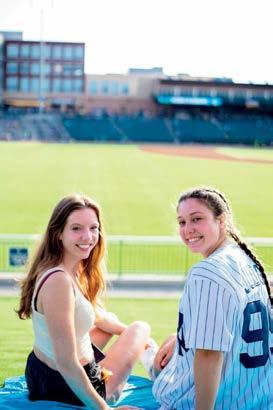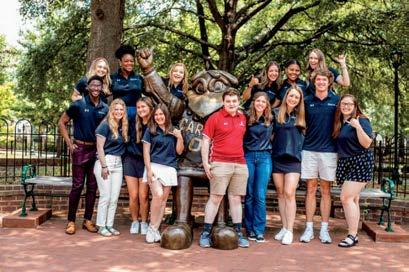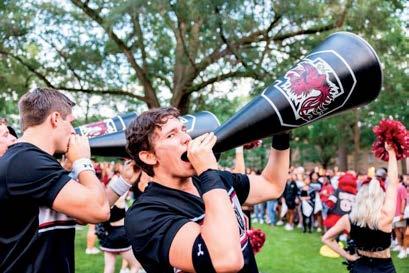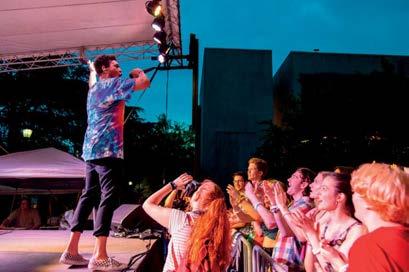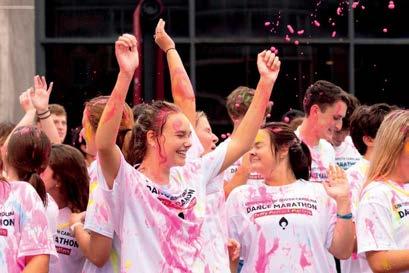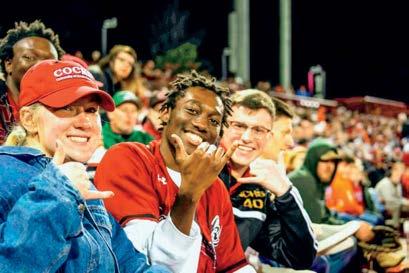How UofSC Paved Over a Black Community
The Struggle Between Faith and Sexuality








How UofSC Paved Over a Black Community
The Struggle Between Faith and Sexuality







STUDENT MAGAZINE OF THE UNIVERSITY OF SOUTH CAROLINA
EDITOR-IN-CHIEF MANAGING EDITOR CREATIVE DIRECTOR ENGAGEMENT DIRECTOR
ARTICLES EDITOR Kendall Vorhis
ASSISTANT ARTICLES EDITORS Ridha Fatima Kelly Hughes
COPY DESK CHIEF Abbie Mott
PHOTO EDITOR Lexi Croft
ASSISTANT PHOTO EDITORS Alyssa Bladzik Laura Lucivero
ART DIRECTOR Melissa Borgerding
MULTIMEDIA DIRECTOR Zane Heinlein
STYLE DIRECTOR Toni Deloach
ASSISTANT STYLE DIRECTORS Benji Early Mia McManus
SOCIAL MEDIA DIRECTOR Anna Ottinger
ASSISTANT SOCIAL MEDIA DIRECTOR Audrey Leach
PUBLIC RELATIONS DIRECTOR Awani Bildikar
AARON FALLS
CHELSEA WATSON
SAVANNAH NAGY
MORGAN PINCKNEY
WRITERS
Kiersten Alexander, Raeva Bali, Maximus Bowman, Hallie Cole, Claire Ellis, Emalee Goode, Jordan Jeffreys, Shakeem Jones, Ella Lukowiak, Ahalya Muraleedharan, Kaylen Pritchard, Allyson Reavis, Laura Rohrer, Gus Varallo
COPY EDITORS
Grace Butler, Francesca Cumello, Suzanna Feeney, Mary Grace Labarowski, Christopher LeBarron, Jase Leonard, Anna Satterfield, Courtney Tsakanikas
PHOTOGRAPHERS

Jaylen Anderson, Alyssa Bladzik, Sydney Bonaparte, Madeline Cesarz, Madison Chiang, Hannah Flint, Jacob Garcia Zambrano, Raynee Quillen, Colby
Sansbury, Allison Smith, Sarah Sutton, Henry Travis, Jackson Tucker
DESIGNERS
Alexandra Adler, Hannah Barrett, Cecilia Callozzo, Shash Comandur, Lily Ferguson, Julia Jackson, Imagine Patterson, Polly Tappan, Alexandra Tudor, Megan Wooters
VIDEOGRAPHERS
Morgan Carter, Faith Fulmer, Anna Heidel, Jalen Miller, Katie Rojas
STYLISTS
Caroline Callicutt, Lauren Cole, Joelle Elliott, Kassidy Hejlik, Jase Leonard, Lily Miller, Tammy Nguyen, Hui Penaflor, Audrey Savage, Angel Sortijas, Kylee Strickfaden, Linh Tran, Maggie Wensink
SOCIAL MEDIA MANAGERS
Bryce Cameron, Sarah Hendrix, Jenna Marandola
PUBLIC RELATIONS MANAGERS
Ambria Gilliard, Imani Polly
AD SALES TEAM
Mackenzie Albrecht, Megan Chong, Ryan Forbes, Hank Lunn, Donovan Ouzts, Christian Rodriguez, Kara Shelmire
CREATIVE SERVICES
Leslie Arango, Beth Bryerton, Sydney Dunlap, Lily Ferguson, TJ Gibson, Sabrina Hampton, Jada Mack, Savannah Nagy
Advertising; (803) 777-3018
To contact G&B, email saganbe@mailbox.sc.edu or visit www. gandbmagazine.com. Garnet & Black Magazine is printed twice a year by students of the University of South Carolina and is distributed for free to members of the university community. All editors can be reached via email on our website. The office is located in Russell House University Union Room 339.
DIRECTOR OF STUDENT MEDIA
ASSISTANT DIRECTOR OF STUDENT MEDIA
ART DIRECTOR OF STUDENT MEDIA
ADVERTISING ADVISOR
FACULTY ADVISOR
Sarah Scarborough
Sydney Cranmer
Krista Larson
Parks Rogers
Scott Farrand
SPECIAL THANKS
Jason Porter
CHANGE AND CHAOS are two of the only constants in life. Since these are inevitable, we must find a way to live through it and find our own source of self-satisfaction. When I first started working for Garnet & Black, I never really wanted to be Editor-in-Chief. I had always told myself that I wouldn’t get too invested and that I wouldn’t work my way up to be the editor. But things changed. Things always change. I became invested. I found something that fulfills me like no other job I’ve had before.
In this issue, you’ll read about how those around us respond when the entire chaotic world is changing and it feels like everything has gone
topsy-turvy. I mean, think about it, we’ve seen more turmoil, tension and conflict in the past several years than in the last couple of decades. That has to have an effect on people, students in particular. The rates of anxiety and depression have increased substantially among college students these past few years. The toll it takes on us is out of our control, but what we can control is how we respond to it.
You’ll read about those of us who use art as a means of self-expression while they face the chaotic world around them. Those of us who persevered when they were uprooted from their homes. And those of us who go on a journey of self-discovery

to reconcile their identities. Each person has a different way of facing the chaotic, ever-changing world around them. It’s not important what you do, it’s important that you do it.
Everyone needs some sort of outlet, something that keeps them grounded when everything is crumbling around them, be it painting, writing or just maintaining close relationships. As for me, I navigated the chaos around me by falling in love with telling stories and finding a like-minded community that has the same passion and drive for storytelling. (I’ll let you guess which community that is.)
As always, thanks for reading Garnet & Black Magazine.
EDITOR-IN-CHIEF AARON FALLSSCHOOL SPIRIT OR ANIMAL ENDANGERMENT?
Take a look into the legacy and controversy surrounding live animal mascots.
UPROOTED ROOTS OF COLUMBIA
How UofSC paved over a Black community.
VIGIL
“Growing is a trauma like grief–it thrives in silcence.”
RECONCILING QUEERNESS AND RELIGION
While some queer students are abandoning their faith, others are celebrating it.
42 44 44
CHAOTIC DREAMCORE
Exploring chaotic dreamscapes through fashion.
TICKET THROUGH DREAMS
A tale of a girl’s wanderlust and dreams.
A LITTLE BIT OF EVERYTHING, ALL OF THE TIME
How companies fight for your attention and how you can resist it.
36 60 62 68 68
FASHION TRENDS UPDATE
From sporty shades to western boots to business core, these are the 10 hottest trends you need to watch out for this fall.
INDUSTRIAL APOCALYPTICA
Distressed fashion in a post-apocalyptic, industrial world.
GARNET & BLACK’S OFFICIAL COCKTAIL
The votes are in–check out the official G&B cocktail for fall 2022.
FROM THE EDITORS
Falling head over heels into chaos.
SUSHI RECIPE: COLLEGE STUDENT EDITION
Want to avoid spending more money on packaged sushi? Look no further.
Does UofSC truly care about student mental health?
Reversing gender roles in classic horror movies—and taking a look at how they’ve changed.
Student shoplifters have more than just tricks up their sleeves (and in their pockets).
Life is beautiful, but life is also painful. Find middle ground with the curated playlist, “Chaotic Bliss Through Sonic Resonance.”
44 53 57 59
FALLING INTO OUR FUTURE
Creative work that represents how these students see their future despite the world falling apart.
70
Some of the most out of pocket things said on the UofSC campus.
WHAT THESE LETTERS MEAN TO ME
How multicultural Greek life builds a sense of community among UofSC students.
An exploration into the niche clubs that make UofSC feel like home.
A poem exploring the behind-thescenes beauty of Indian-American households.
The presence of live animal mascots is prevalent in college sports culture. Take a look into the


end of the day, both sets of owners agreed to keep Sir Big Spur’s name, just in time contribute to the lively atmosphere of Williams Brice Stadium. Live mascots amongst students and fans. To address the elephant in the room,



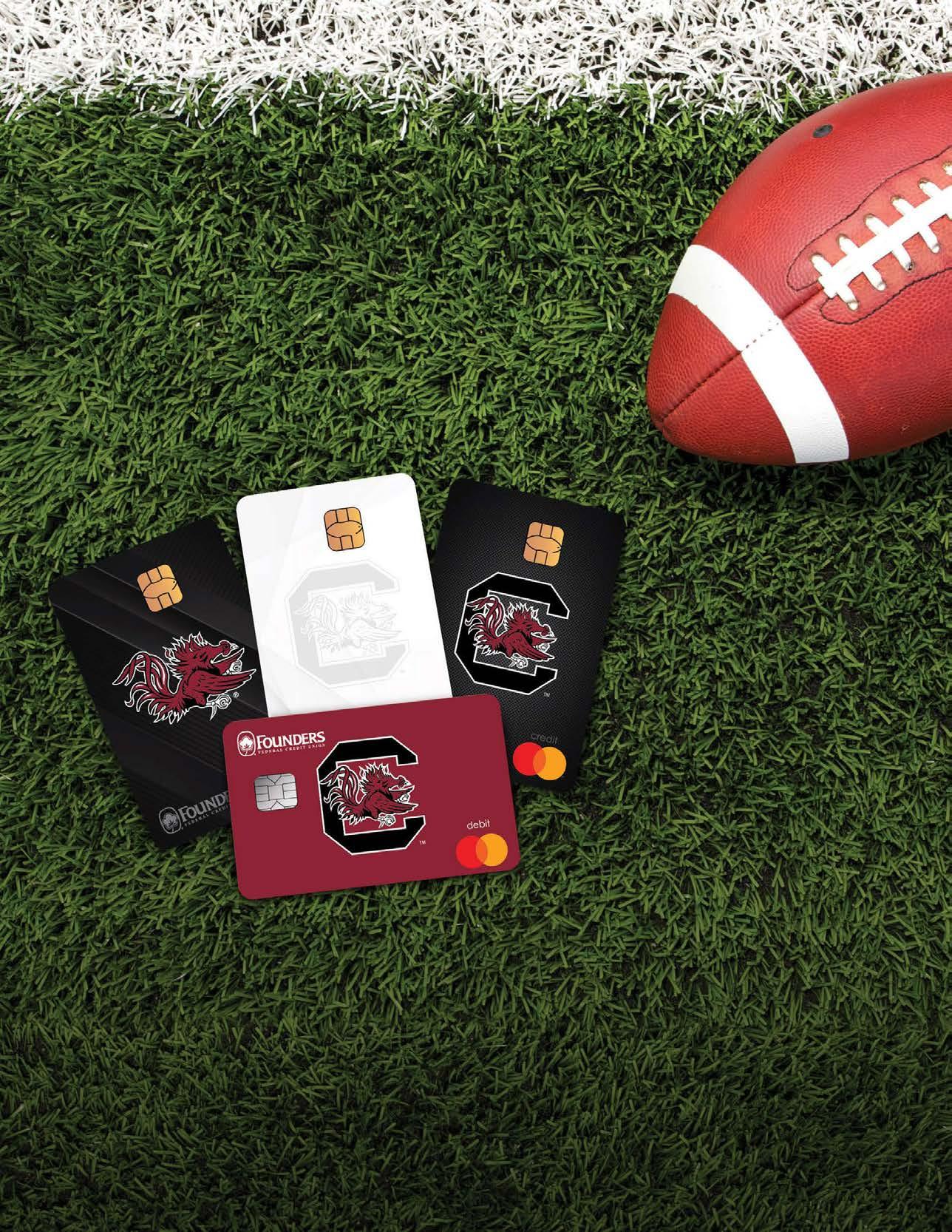

AT THE START OF THE 20th century, Columbia was a promising city. It was a textile manufacturing hub. It already housed the University of South Carolina, Allen University, Benedict College and
as “overcrowded with deteriorating housing and lack[ing] infrastructures like indoor plumbing, electricity, paved streets, sidewalks and garbage collection” in “The Evolution of Columbia’s neighborhoods”.
Columbia Female College. There was a sense of optimism in urban life. All over the country, people left the countryside to work in urban factories or mills.
It was not all that promising, though. American cities as we know them today are the result of decades of residential segregation, and Columbia is no exception.
Columbia was a crowded and dirty city. The Great Depression hit hard, and discriminatory social conditions called Jim Crow laws set racial segregation in stone. As it always was, white people were worthy of space, and Black people were not.
Dr. Bobby Donaldson is a UofSC history professor and the USC Center for Civil Rights History executive director. He researches the history of Black neighborhoods, among many other topics. According to Dr. Donaldson, the heart of Columbia as we know it was home to disenfranchised minority communities up until the past 40 years. The people who lived there faced rundown and crowded conditions with poor sanitation.
Wheeler Hill, located near Bates House and the Campus Village, was one of these communities. Once a lively and close-knit neighborhood, now only about a hundred homes remain, UofSC graduate Sophie Kahler discusses in “Wheeler Hill.” It was a “self-sufficient and proud community.”

Kahler describes these neighborhoods
Still, city developers saw economic potential in Wheeler Hill and other working-class Black neighborhoods. The City Beautiful movement swept the U.S. to enhance the “aesthetic environment of its many inhabitants,” writes the New York Preservation Project.
In “The Evolution of Columbia’s Neighborhoods”, Kahler states that “trends of urban development and racial segregation,” such as urban renewal, redlining and racial zoning, “manifest in Columbia’s neighborhoods and contribute to larger racial inequalities.”
Urban renewal was a national movement to rid cities of sums and beautify cities. The city of Columbia, University of South Carolina, Columbia Housing Authority and federal government ran with this. They planned to spruce up the city and were largely successful. Since the mid-20th century and into the 2000s, Columbia has seen improved roads, landscaping and attractions, like shops and museums.
“The heart of Columbia as we know it was home to disenfranchised minority communities up until the past 40 years”
Almost everyone believed urban renewal was for the public good. A flourishing city is clean. It has exceptional schools and homes with manicured yards—but at what expense?

To make room for a profitable and aesthetic city, they had to eliminate Black neighborhoods. Thus, redlining was born. Redlining is “a discriminatory
white neighborhoods.
Title I of the 1949 Federal Housing Act funded the local Columbia government development. “The victims, those who ultimately suffer in that process are poor, working-class Black and brown people,” says Dr. Donaldson.
Dr. Donaldson asserted, “There was no way the University of South Carolina could have grown to the south and to the west without eminent domain and the acquisition of those properties.” Eminent
practice that puts services (financial and otherwise) out of reach for residents of certain areas based on race or ethnicity.” Under the New Deal, the Home Owner’s Loan Corporation (HOLC) intended to aid homeowner’s on their mortgages and foreclosures. They made it clear that a flourishing city is a white city.
Although redlining is illegal, that didn’t stop developers. In 1927, the HOLC created a map that ranked neighborhoods from A-grade to D-grade based on their appeal to investors and homeowners. Disenfranchised neighborhoods were labeled D-grade, purposely singling out the Black innercity communities. These neighborhoods’ estimated income ranged from $200$10,000. Lenders intentionally gave less to minorities. Naturally, the wealth divide between white and Black Americans grew.
Columbia soon followed the national pattern of “white light.” White residents moved away from urban Columbia and into neighborhoods, sparking the growth of suburbs that today we recognize as Forest Hills and Shandon. To make matters even worse, the Federal Housing Administration strictly urged employees only to insure home mortgages in
domain allowed the local government to seize private property for the public good. Columbia developers demolished the inner city, as they perceived the people who lived there as threatening to the “social, moral and economic health of the entire city,” Kahler wrote. Throughout the 1950s and 1960s, the local government destroyed 600,000 housing units.
Activists fought to preserve Blackowned spaces. UofSC bought the historic Booker T. Washington High School in 1974, which has educated Wheeler Hill
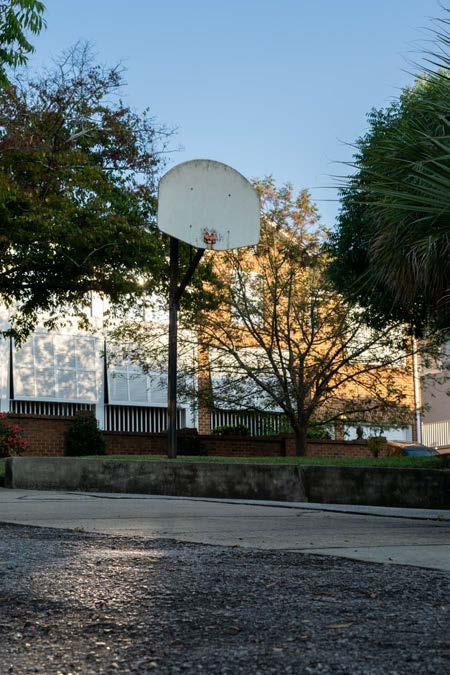
“UofSC students deserve to know the history of Columbia and their school”
and Ward One’s youth since 1916. The university demolished the main building and transformed another into the Booker T. Washington Auditorium. Students and their families protested the sale in favor of preserving Black-owned spaces under federal slum clearing programs. Meanwhile, UofSC was building white educational facilities in their place. Black inhabitants had no part in the “greater good” of Columbia.
While some struggled to maintain the pillars of their communities, Columbia
“inclusiveness and innovation to successfully address local issues.”
UofSC,the City of Columbia, the Columbia Housing Authority and the federal government justified this urban renewal effort with a “compelling case,” Dr. Donaldson explained. The economy would improve and taxpayers would be satisfied. After all, they created student housing, educational buildings and arenas.
Before this expansion, which primarily took place in the early 1970s-1980s,
developers began the “fight blight” movement. Bloomberg describes blight as “a disease that threatened to turn healthy areas into slums.” In 1951 and 1964, the National Civic League even granted Columbia the All-America City Award, which honors cities that promote
Blossom and Sumter St. were UofSC’s boundaries, Dr. Donaldson said.

UofSC continued growing after the eagerness for urban renewal finally died down in the 1970s. The university acquired and destroyed Black homes, Black churches and Black businesses. Ward One stood in place of our iconic UofSC attractions. If you live in the Greek Village, work out at Strom or attend shows at the Koger Center, you’ve walked the same grounds the city and university once deemed slums.
Ironically, the university most recently took its most significant growth to what was once the center of Wheeler Hill. In place of the disenfranchised community, modern high rises house thousands of students. UofSC calls this project the Campus Village. The UofSC Facilities Department wrote, “The project’s design, while contemporary, was planned in collaboration with adjacent neighborhood groups and will adhere to existing community and university aesthetics.”
Most displaced families
resettled in the north Main St. area and beyond Williams Brice Stadium. Remnants of Black neighborhoods exist in what Dr. Donaldson calls “the direct shadow” of the campus. St. James AME Church on Henderson still operates. Another Black school building in the area called the Benson School remains but is now owned by the university.
“It is a tragedy that has been repeated in nearly every major city in this country,

“You’ve walked the same grounds the city and university once deemed slums.”
where a core downtown community had lived, thrived, and then business people, education leaders, elected officials then decide that for the betterment of the community, we’re going to move into these properties,” Dr. Donaldson said.

“What I’ve tried to make the case to the university leadership is that you will build these buildings, but at least acknowledge where they are, and tell the context of the history,” says Dr. Donaldson. UofSC
students deserve to know the history of Columbia and their school, even if it doesn’t paint them in a positive light.
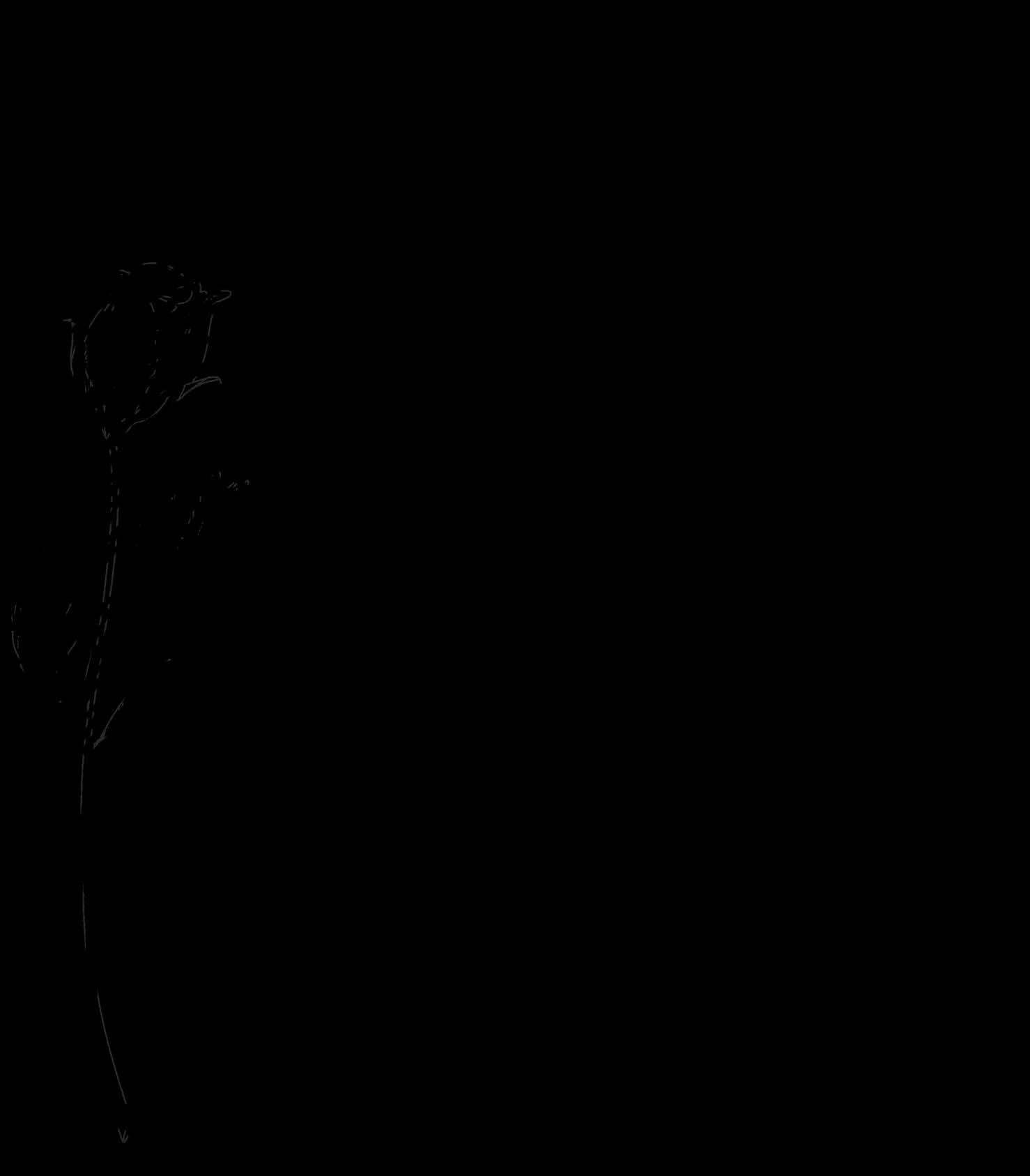

IF YOU HAVE EVER walked down Greene St. you are likely no stranger to the streetside evangelists passing out pamphlets or proclaiming biblical teachings through megaphones. You may hear what some ascribe to be gospel truths, but many have also been subjected to threats targeted towards queer students that promise them damnation if they do not denounce the non-heterosexual, non-cisgender parts of themselves. In the face of this, there is also a good chance that you have seen groups of UofSC students banding together to take a stand nearby holding pride flags.
These occurrences have become so well known across campus that they have even made it onto platforms such as TikTok and Instagram. It is no wonder why so many people have come to associate faith with bigotry, and it has caused a multitude of students to step back from the religions in which they were raised. There are also queer students on campus who have found their true selves in both their sexual identity and their religious beliefs.
Lenyx Coviak, a student who has
grown tired of people using religion as an excuse for hate, recalls how the household Christian faith hindered their own self-discovery journey. Coviak is non-religious, but they shared that they did attend church every now and then in their childhood. Though these visits were infrequent, Coviak said that they did result in some internalized homophobia that made growing into their nonbinary identity somewhat daunting. “I had always been queer. I just never had the words for it until I got older. And then when I did, the immediate feeling was ‘something’s wrong with me. I am not correct,’” Coviak said.
Many queer people do not realize that they are queer until they are older but some begin to notice it when they are very young. Lots of things that are innately a part of what makes you yourself are often difficult to quantify or put into words until you have the vocabulary to do so. Those raised in religion are often taught myths or untruths about what it actually means to be queer.
Though they are very comfortable and secure in their identity, Coviak said that the way in which the church presents

queerness to congregations greatly contributes to false beliefs about the LGBTQ+ community, even down to the biology of being queer. “I know people who assume that being queer is a choice because their religion makes them assume that being this way is a choice. It makes it hard as a queer person because it immediately comes with dehumanization.” People are
naturally drawn towards communities that celebrate every part of who they are, and such dehumanization is the crux of why so many queer people feel they cannot find a home in religious spaces.
Another student, Yasmen Balogun, reflects on how being raised Muslim in Nigeria, a country where same-sex marriage is not recognized and even
BYKAYLENPRITCHARD•PHOTOBYHANNAHFLINT•DESIGNBYALEXANDRATUDORIhadalwaysbeen queer.Ijustneverhadthe wordsforituntilIgot older.AndthenwhenIdid, theimmediatefeelingwas ‘something’swrongwith me.Iamnotcorrect’.
punishable by death, has influenced her journey into discovering her sexuality. While no longer Muslim, Balogun mentioned that there had been a divergence in her mind between the teachings of God and the teachings of religious scholars. She said, “My mindset was that there’s no way God is against this if this is just what I am, and I think for a long time, I tried to make both things work.”
People have never been and will never be one size fits all. There will always be members of the LGTBQ+ community within and outside of religion, and people’s experiences are just as diverse as their sexualities, gender identities, faiths and everything else that makes them who they are. Diversity is something that should not merely be tolerated; it needs to be embraced. Unfortunately, not all queer people experienced this kind of acceptance growing up.
Balogun recalls how her sexuality has been condemned by multiple members of her family, even those who have done things widely accepted as immoral, such as cheating on their spouses. This brought to light a fierce double standard and a stark hypocrisy. It reminded her of John 8:7, a Bible verse that states, “He who is without sin among you, let him be the first to cast a stone.”
Many queer people have been baffled over the years by how religious institutions that preach so vehemently against casting judgment have produced some of the people most well-known for bombarding them with hateful words. Some will even go as far as to say that their issue isn’t with the religion itself. It is with those who follow it.
In response to this hypocrisy, Balogun implores everybody, be they religious or otherwise, to assess how the world around us has impacted faith and morality. “You must recognize that a lot of what you are taught by faith has a lot to do with culture, and it’s important to separate that.” Common cultural beliefs can impact
people’s preconceptions about anything. When misinformation is targeted towards marginalized groups, it leads to prejudice that can be heard from family members, news or the pulpit.
Even within the school setting, topics such as sex education can be prejudiced against queer youth. A national study found that just 4% of high schoolers recall having a queerpositive discussion when it came to sex education, if they had such a discussion at all. According to Child Trends, only 17 states (including Washington, D.C.) have at least 50% of public schools integrating LGTBQ-inclusive curricula in their sex ed programs. These kinds of additional factors can influence a young queer
Don’ttryandsuppress it,becausethat’snever goingtowork.Ifyourfaith issomethingthat’s importanttoyouaswellas yoursexuality,youjust havetobewillingto addressthatdirectlyand openlyandfindpeople whoyou’recomfortable doingthatwith.Findthose spaces.
person’s image of themselves and make self-discovery much more difficult than it needs to be, and it can also impact the way in which the general public views queerness.
Young people are leaving the church at a faster rate than ever before. According to the Journal for the Scientific Study of Religion, there is a strong association between queer identity and stepping away from religion either partially or altogether. However, there are still students who are emboldened by embracing both their queerness and their faith.
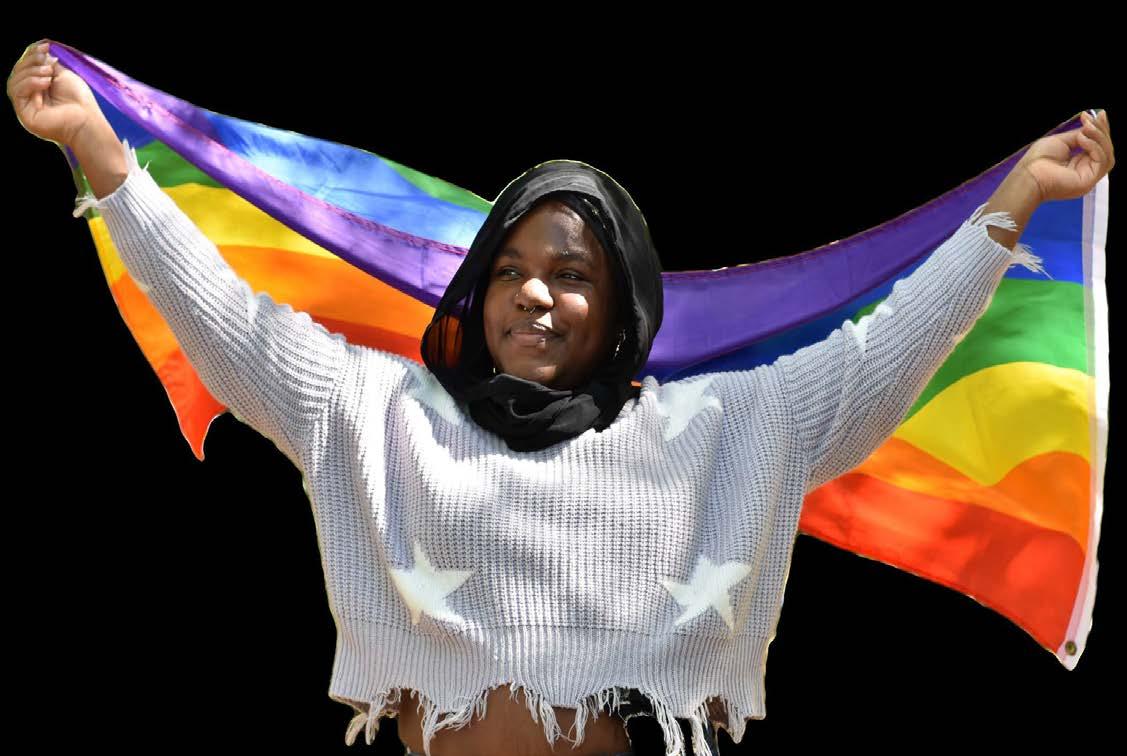
Deven Hull, a UofSC freshman, has navigated the often daunting
intersection between faith and sexuality for years. While some devout religious families have very limited, critical feelings towards queer sexualities, Hull shared that he was presented with a somewhat middlegrounded expectation from his parents. “As a non-denominational Christian, I was raised to believe that being gay wasn’t sin, it was just a temptation that would be presented to me, but that for me to then act on it would be sinful.”
Finding a safe space in which you can unapologetically show all parts of yourself is not always easy. Many find that it is quite the contrary. However, Hull and others in a similar place will tell you that it is far from impossible.
Hull has found a community within the Columbia Church of Christ that empowers him to celebrate both his faith and all other parts of his identity. Religious people with queer gender or sexual identities often feel pressured to choose between two parts of themselves, but Hull urges other young queer people to embrace their identities as well as whatever religious beliefs they may feel impassioned to practice. “Don’t try and suppress it, because that’s never going to work. If your faith is something that’s important to you as well as your sexuality, you just have to be willing to address that directly and openly and find people who you’re comfortable doing that with. Find those spaces.”
Whether religious or non-religious, queer people deserve to be celebrated. Some find wonderful groups on campus that accept both their faith and their sexual or gender identity, but others sometimes do not. Every experience is as diverse and valid as the next. Regardless of how you identify, there is a place for you, and there will always be people from different walks of life who will come alongside you in genuine care and love.




Does the Thomson Center provide adequate resources and assistance to students in need of mental health and well-being assistance?
BY ELLA LUKOWIAK • PHOTO BY AARON FALLS • DESIGN BY HANNAH BARRETTAnxiety. Depression. Suicide. Therapy. These are all words that make many children, teenagers and adults squirm in their seats. It is uncomfortable to face these dark conversations.
“It’s embarrassing,” a student might whisper, afraid of speaking about how they feel. “It isn’t really anxiety,” a parent might say, planting that detrimental seed of doubt in their child’s mind that influences years of health decisions.
Even if a person tries their hardest, there is always something else to do: school, work, laundry, finances, exercise, classes, social life, etc. Mental health is usually not at the top of a person’s to-do list, and it looks like it isn’t at the top of the university’s, either.
On the UofSC campus, the Thomson Center is the hub of mental health resources. This building, tucked behind the brand new Center for Health and
Well-Being (CHWB), has been serving Gamecocks for 45 years in all areas of wellness, but it was recently designated as the space solely for mental health resources. All other departments were relocated to the new CHWB complex that opened in July of 2017.
While this center is fully funded and brand new, the Thomson Center is understaffed and still waiting on vital funds to allow its staff to provide students with
adequate resources.
Student mental health statistics on campus over the years have changed as well. According to an article by Abe Danaher, “on South Carolina’s campus between 2019 and 2021, UofSC students diagnosed with depression increased from 20.1% to 23.1% and anxiety increased from 26.2% to 32.9%.” Whether this increase correlates with the transition period from the Thomson Center to the CHWB cannot be said. Still, various students have found difficulties in trying to take advantage of mental health resources on campus.
Sophomore Hope Fahrner has previously used the counseling services provided, but it took two weeks just to secure her initial triage appointment.
“By that point I felt like my [mental] state had changed and my attitude about whether or not I wanted to try therapy had kind of changed, too,” Fahrner said. “I started working on my own coping skills. Whether or not they were positive or negative, who knows?”
Another sophomore, Katelyn Fry, shares Fahrner’s frustrations about scheduling an appointment as she was not able to get an appointment with a counselor at all.
Fry had been seeing both a psychiatrist and therapist at home, who knew her medical history as well as the things she had been diagnosed with, but was turned away from counseling services at the Thomson Center.
“I went and told the person in my initial intake things that I had been working on, or things that I had been diagnosed with, and they were kind of just like ‘No I don’t think I see that’ or ‘Are you sure that that’s right?’” Fry said.
At the end of this initial evaluation, the counselor offered to give Fry the names of other service providers in the area, but did not think she needed help at the time.
“...[E]ven if I wanted to see somebody, they didn’t think I needed to,” Fry said. “In that aspect, it’s not really fair to the student because I feel like the student knows more about their own situation rather than the person they are talking to.”
Due to an inability to use the counseling resources, Fry turned to an alternate option: a wellness coach provided by the CHWB. This is an available resource for those who may not be able to schedule a counseling appointment, or simply want help that is more tailored to a specific area; these include balanced eating, physical activity, stress management, sleep, tobacco treatment or resiliency, according to the Student Health Services website.
While Fahrner was able to get in to see a counselor, she also eventually turned to other resources due to a lack of satisfaction with the Thomson staff.
She explained that her expectations of the counseling were that she would have her thought processes broken down and be provided with techniques to use. For her, that was not the case.
“Once I had the appointment it really didn’t feel very productive for me, and I haven’t tried therapy before, so I can’t specifically say that they were a ‘bad therapist,’ but I didn’t learn any tools to use or anything,” Fahrner said. “It was kind of just I was sharing my story and she was like, ‘Oh, that really sucks.’”
At the end of her appointment, there was no follow-up suggested or scheduled by the counselor, so Fahrner turned to
While living at Preston Residential College last year, Fahrner began to create a program called “Mindful Mondays” and was looking for something to supplement this practice and offer to those looking for help. Before she recommended it, though, she wanted to try the program.
TAO is UofSC’s online module program that provides students with meditation audios, mindset training and other resources for mental health and well-being. This can be done completely on one’s own without any appointment needing to be made. Due to the online nature of the program, however, it may not be effective for all students.
Although Fahrner and Fry had difficulties regarding counseling at the Thomson Center, freshmen Maura Hamilton and Aurora Swain had very different experiences.
Hamilton has never had counseling before, stating that her parents “don’t believe in mental health” and therefore limiting her opportunities. When she came to college, however, she knew she wanted to use the on-campus resources. For her, it was simple: google “UofSC Mental Health” and make an appointment online. She did this easily, without any complications or delays.
“I’m 99% sure I did it a week later because they were like ‘Oh you could do it at 6 o’clock today,’ but I just didn’t have the free time,” Hamilton said.
When it comes to the sessions themselves, Hamilton has been pleasantly surprised.
“Last time I walked out of it and was like ‘Wow, I feel so much better’ as if the whole point of it isn’t supposed to make
you feel better—it’s just weird it works,” Hamilton said.
Swain also had no issues scheduling an appointment and enjoyed the services provided, stating that the sessions at UofSC have felt similar to her prior experiences in counseling.
“It’s genuinely just like having a private therapist,” Swain said.
The contrast between the two sets of stories regarding the Thomson Center raises concern, and it almost seems as if students are reaching blindly into a pool and hoping they have a positive experience. When it comes to something as delicate and vital as mental health, having access to adequate resources should never be luck of the draw.
In terms of getting emergency care, however, a student who wishes to remain anonymous has verified that they were well taken care of.
“I had to have an emergency appointment last year because my mental health was really bad,” the student said. “After that it was actually really easy, and they kind of expedited my process in comparison to others because I was at risk.”
While they had a good experience with the Thomson Center, the student also recognizes that this isn’t the case for everyone who needs help. They propose that the center makes a change in how the intake surveys are filled out.
In order to schedule an initial appointment, a student must fill out a small questionnaire. This survey does not become available, however, until after the appointment is scheduled. This student suggests that prospective patients should be able to fill out the survey as they are trying to schedule the appointment in order
to evaluate how immediate their need to see a counselor is.
“I’m not saying no one doesn’t deserve it, but if people are at a higher risk for suicide or anything like that, I think that obviously they should be placed more on the priority list,” the student said.
For a lot of students on campus, the problem isn’t just not being able to get in with a counselor, but not knowing where to look for these resources in the first place.
Fry believes that sending out an email to the student body would be most beneficial.
“I don’t know exactly how they would do that, but just sending out a campus-wide email just with mental health resources and direct links to how you can sign up or how you can get in contact with those people would be very helpful,” said Fry.
Despite the variety in student experiences, most agreed on one thing: the Thomson Center has potential that is not acted upon due to mental health not being a top priority for the university.
When the CHWB was first established as a separate building in 2017, an article published on the UofSC website about the opening wrote that the Thomson center “will be renovated” but there are no further statements describing any such renovations. While the article also states that mental health is one of the university’s primary concerns, the building for these resources is 45-years-old, without many updates, standing beside a new, fullyfunded health center.
The Thomson Center also has a considerably smaller staff than the CHWB. On the Faculty and Staff Directory for Student Health Services, only 35 out of the 155 names were for staff members under the “counseling” filter. While there is less of
a variety of roles to be filled in the Thomson Center versus the Center for Health and Well-Being, the need for a large staff is just as great. In a school of almost 27,000 undergraduate students, having only 35 counselors available is not an adequate amount to ensure students have the opportunity to truly take advantage of the resources at the Thomson Center.
Fahrner believes that these 35 staff members are doing what they can, but sometimes that just isn’t enough.
“When talking to people who are actually a part of the mental wellness team in some way I honestly do feel like they really care. I think the hard part is just making it all happen,” she said. “I think people have a lot of ideas, but again, I feel like mental wellness usually gets put at the end of the to-do list.”
Swain adds that it is the lack of financial assistance that may be withholding the Thomson Center from reaching its full potential.
“If they were better funded they could do so much more, and the employees that make up Thomson would gladly do it, I think,” Swain said.
This range in experiences among students incites a need for the Thomson Center to truly evaluate the quality of its services and their accessibility to the student body.


“I do think we have the resources,” the anonymous student said, “I just don’t think they are being executed as well as they could be.”
Mental health should always be a top priority. If you feel it falling to the bottom of your to-do list, spend a few extra minutes with yourself to evaluate and check-in.

“I do think we have the resources, I just don’t think they are being executed as well as they could be.”
For anyone that may be looking for help, please refer to the following resources:




 BY
MAX BOWMAN • PHOTOS BY HENRY TRAVIS & RAYNEE
QUILLEN • DESIGN BY MELISSA BORGERDING • STYLED BY
BENJI EARLY • MODELED BY MADDIE ZEDIKER, BILLIE SCOTT, WILL MEARES, WIL EVANS JR., AND LUKE ROBERTSON
BY
MAX BOWMAN • PHOTOS BY HENRY TRAVIS & RAYNEE
QUILLEN • DESIGN BY MELISSA BORGERDING • STYLED BY
BENJI EARLY • MODELED BY MADDIE ZEDIKER, BILLIE SCOTT, WILL MEARES, WIL EVANS JR., AND LUKE ROBERTSON
YOU SLOWLY GET UNDRESSED, sweat
sticking to your skin as you step into the showers after your PE class. Suddenly, you feel a throbbing pain from inside of you, bringing you to your knees as you cry out in equal parts shock and pain. You bring your hand down to the pain and when you raise it up to your face, it’s covered in blood. Screaming, you run out of the shower, worried you’re dying and you need help. But, as you look at everyone around you, you see faces of disgust instead of fear. “Plug it up!” they scream, throwing strange objects at you while you bring your hands up to cover your face. Your teacher stands off, refusing to stop the onslaught as the mob jeers at you, their insults confusing you even more as you feel the pain throb all the while.
What you just read was a scene adapted from the 1976 movie “Carrie,” directed by Brain de Palma and based on the bestselling Stephen King novel. In the movie, Carrie White is a shy high schooler who has her first period at the age of 17, and is ruthlessly mocked about it by her peers when she
doesn’t understand what’s happening. At home, her Catholic mother learns of her period and demonizes her child, as her faith has radicalized her into believing periods are the sign of a woman’s impurities and loss of sexual innocence. The mother is incredibly abusive to her child, shaming her for sexual actions which never occurred, and even locks Carrie in her closet for several days at one point.
However, Carrie simultaneously develops telekinetic powers that grow in strength as the movie progresses. Finally, due to the horrific abuse of her mother and a prank to dump pig’s blood on her as she is jokingly named prom queen, she goes psychotic, killing her abusers and going on a rampage throughout the entire city in revenge for what everyone has done to her. This film, and the book it adapts, perfectly exemplify the complex nature of women’s representation in horror media. Empowered female characters are contrasted with horrific crimes against female characters, along with monstrous feminine imagery.
This ultimately displays anatomy in a dangerous and horrific light, creating the aptly named ‘Monstrous Feminine.’ Tying Carrie’s psychic abilities and her rampage to her puberty, portrays puberty and the female anatomy in a concerning light, even if Carrie herself is an empowered character because of her abilities.
“Aliens” is a 1986 sequel to the horror classic “Alien,” starring Sigourney Weaver as Ripley and directed by James Cameron. In the movie, the reproductive cycle of the titular aliens, known as Xenomorphs, is fleshed out. An Alien Queen lays eggs that, when disturbed, attach themselves to the faces of bystanders and implant eggs inside the host. The host’s DNA is incorporated into the implanted alien, growing the tumor from the host’s body until it bursts out and later molts to become a Xenomorph, the ultimate killing machine. This process corrupts the natural reproductive cycle of humans and, in Cameron’s own words, serves as a “monstrous analogue to Ripley’s own maternal role in the film.” incorporated
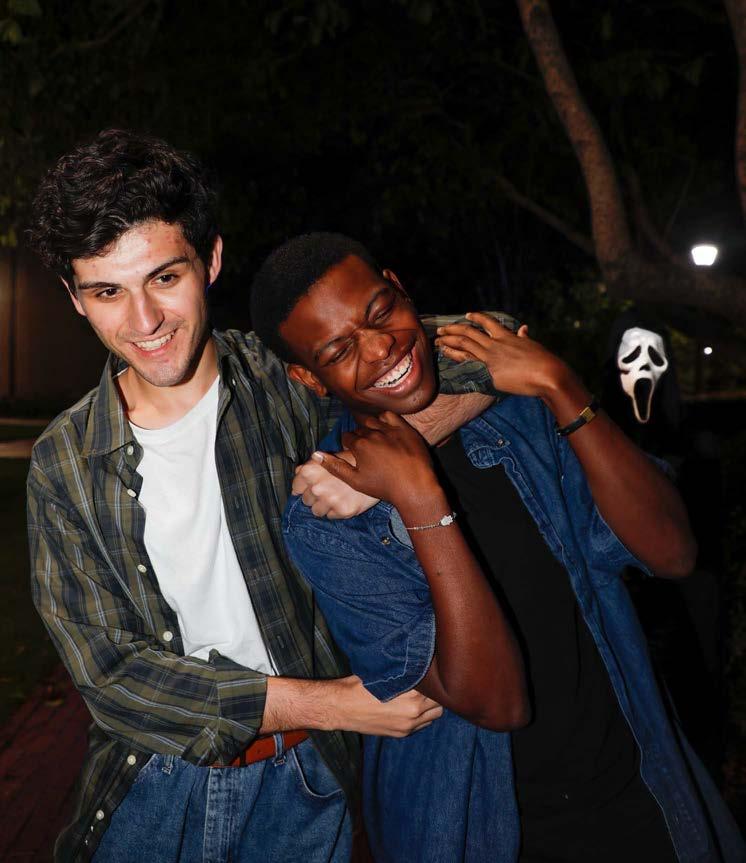
into the implanted alien, growing the tumor from the host’s body until it bursts out and later molts to become a Xenomorph, the ultimate killing machine. This process corrupts the natural reproductive cycle of humans and, in Cameron’s own words, serves as a “monstrous analogue to Ripley’s own maternal role in the film.”
The “Exorcist,” a 1973 film directed by William Friedkin, features a twelve-year-old girl possessed by a demon which must be removed by two priests. The once innocent young girl is morphed into a demonic, sexual monster that embodies all of what is traditionally seen as sin in Christian culture. Julia Elliott, a professor of women and gender studies here at the UofSC, commented that all of these movies were created during the second wave of feminism in America.
“The second wave of feminism was sweeping the nation at this time, which came with more rights and sexual empowerment for women. In response, these movies portrayed female sexuality and biology as grotesque and dangerous,”


Elliott says. These movies, intentionally or unintentionally, work to demonize the sexual empowerment of women and view that empowerment as monstrous and dangerous to the status quo.
Slasher films, such as “Halloween,” released in 1978, “Texas Chainsaw Massacre,” released in 1974, and “Scream,” released in 1996, show many other flaws with women’s portrayal in horror at that time. These films featured masked men who murdered primarily women, often in brutal and torturous ways. Often these female victims were sexually promiscuous or taboo, and death from the murderer was seen as a sick sense of revenge for their supposed sin. And even though many of these movies featured a strong woman who killed the murderer in the end, they were often seen as sexually innocent, pure or simply tomboyish in nature.
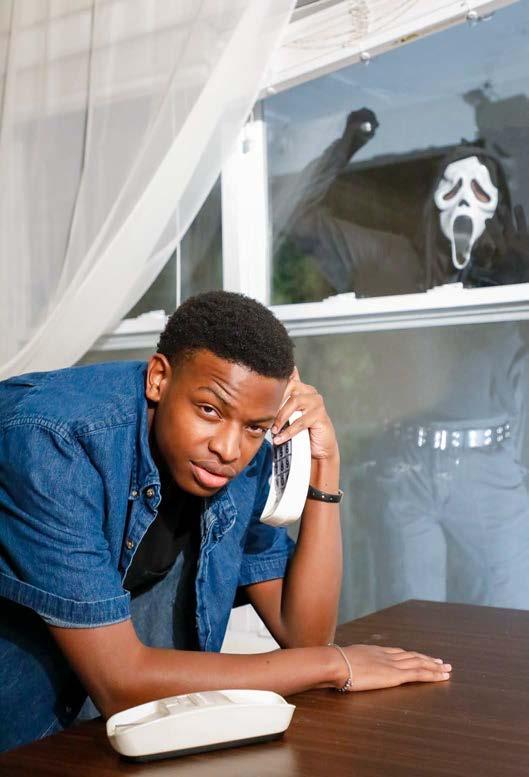

This creates a complicated portrayal of women, where a women is only strong if they fit a very narrow sense of what a woman can or should be. The masked nature of these villains also mirrors the
silent crimes that women faced during this period and still face today. We live in a world where women are afraid to speak up against ‘invisible’ killers and are constantly treated like crimes against them are their fault because they ‘shouldn’t have worn that dress’ or ‘they should have known what would happen to them.’
Recent movies, however, have made a push to rectify women’s portrayal in film and rebrand this ‘monstrous feminine,’ as many female directors are now using this trope in order to push women’s issues and further women’s progress.
“There has been an explosion of sorts in the film industry with women directors and the ‘monstrous feminine.’ These directors are creating self-consciously feminine films that are sympathetic to the woman’s plight, and use this trope to showcase that plight,” said Dr. Julia Elliott.
One of the best examples of this is the 2014 movie “Babadook” directed by Jennifer Kent. In the movie, the monster known as The Babadook manifests itself as a symbol of a woman’s grief and anxiety
as a single mother caring for her only son. The female lead is shown to have sexual agency over herself but is not sexualized, and the movie discusses taboo subjects related to motherhood, such as anger or frustration with your child. The movie also never tries to imply that it is the mother’s fault for the monster or the haunting that happens to her and her kid. This movie turns the ‘monstrous feminine’ trope on its head, and uses it to portray women’s issues instead of demonizing women’s bodies, and that works to help empower women and have their voices heard.
“Titane” is a revolutionary and innovative movie made in 2021 and directed by Julia Ducournau. It shows a woman, Alexia, a serial killer who falls in love with and has sex with a car. It’s a movie that Dr. Julia Elliott states, “exploded the idea of the nuclear family and of sexuality in general.” It’s a deeply provocative film about gender, sexuality and trauma and uses body horror and a spin on the ‘monstrous feminine’ to talk about complex issues. “Raw,” a 2016 film also directed by Julia Ducornau, is a coming-of-age story using the body horror
and monstrous nature of cannibalism.
“Jennifer’s Body,” a 2009 film directed by Karyn Kusama, satirizes the demon girl trope and pokes holes in its messaging.
“The Witch,” a 2016 film directed by Robert Eggers, showcases the liberation of a woman through witchcraft.
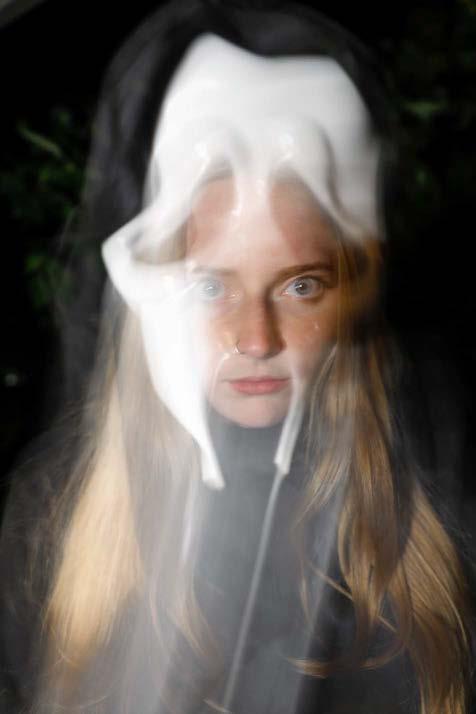
None of these films portray violence against women in a positive light, or claim that the women deserved it for acting in a taboo way. They treat violence on women like a crime, and the women are treated as victims that need help. On top of that, these films work to deconstruct the ‘monstrous feminine’ and actually use it to showcase woman empowerment. These movies deserve to be lifted up for their feminist messages.

Dr. Julia Elliott teaches a course at the South Carolina Honors College here at UofSC called “Monstrous Mothers, Diabolical Daughters, and Femme Fatales: Gender and Monstrosity in Horror Films.” This course delves much deeper into the way second-wave feminism was treated by male directors at the time, the way they pushed to demonize woman’s biology
and sexual freedom, and the way female directors are taking that power back. The Columbia State Museum also hosts film screenings of several of the movies listed here, including “Titane”.
Films like these and seminars led Dr. Elliott work to uplift the feminist voice and take back the power that male directors have had over the feminine portrayal in horror. As such, it is incredibly important to support these films and professors, like Dr. Elliott, because they are fighting an uphill battle to change the way the media sees women.
It is important that society sees a woman’s body for what it is. It is not monstrous, and it is not dangerous. It is not something to be feared, hated or oppressed. A woman’s body is hers, and she is free to do with it what she pleases, and there will never be anything scary about that.
SINCE HORROR was first brought to the silver screen, the male-dominated film industry has portrayed women as hypersexual, ditsy, submissive, or a “damsel in distress.” These rigid, surfacelevel depictions are emphasized through “the male gaze,” where women are filmed from vulnerable, domineering angles, or have lingering shots of their exposed skin. This phenomenon is damaging to the perception of women as a whole, reducing them to objects.
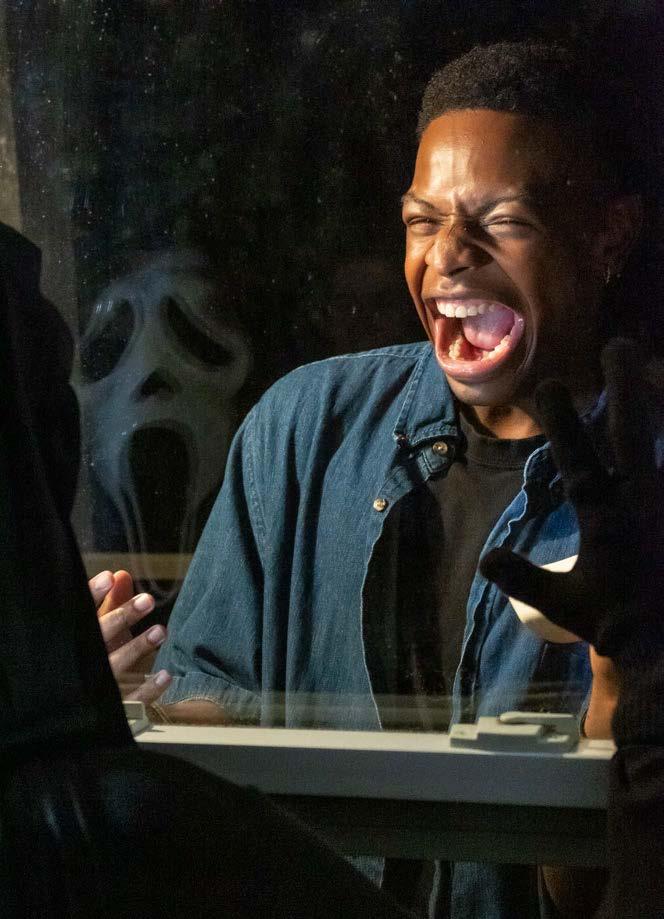
The portrayal of women in “Scream,” directed by Wes Craven, stands as a prime example of the male gaze. The opening scene details Casey Becker flirting with an unknown man who later kills her, justifying
her “promiscuous behavior” as a reason for her murder. On the other hand, “Carrie” director Brian De Palma depicts Carrie White as an innocent and shy girl abused by relentless school bullying and her mother’s extremist beliefs. Both films illustrate themes of feminine submissiveness and victimization.
To criticize the violence that women face in horror movies, we gender-swapped the lead characters in both “Scream” and “Carrie.” With this shoot, we want to encourage readers to reflect on their own predispositions of who should be an antagonist versus who should be a victim, and why we have these biases in the first place.
 All clothing is thrifted unless otherwise noted.
All clothing is thrifted unless otherwise noted.

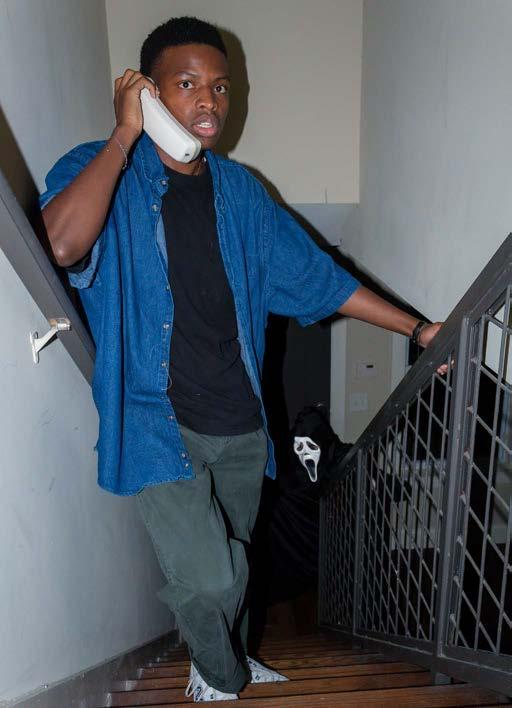
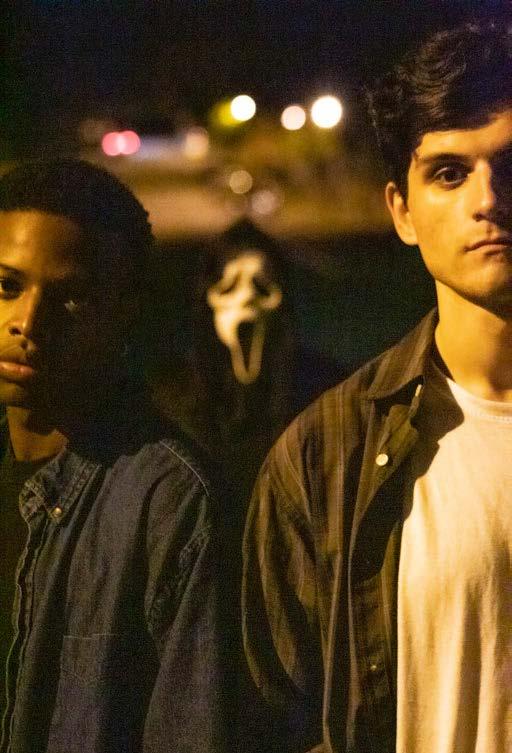
 Shoes: New Balance
Scream Mask: Amazon Cloak: Walmart
Shoes: New Balance
Scream Mask: Amazon Cloak: Walmart
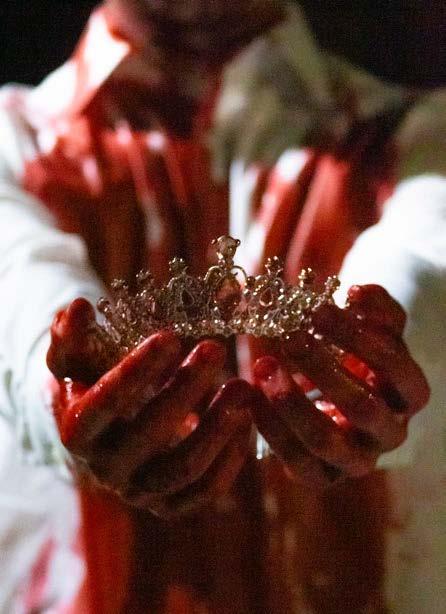
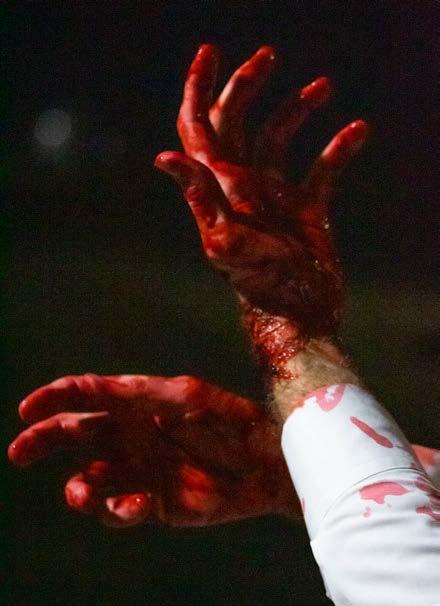

IT STARTS OFF SMALL. Maybe it’s a pack of gum, some dainty earrings or a lighter—something small enough to fit in your pocket or the sleeve of your hoodie, maybe your ol’ reliable tote bag. It’s small enough to not be “a big deal,” a “they won’t miss it” kind of thing, and the risk seems a lot lower than the reward. When you’ve gotten away with shoplifting once, the second time doesn’t seem that daunting; or the third, or the fourth and so on.
According to the National Association for Shoplifting Prevention, about 1 out of 11 people in the United States are shoplifters, and 55% of them start when they’re teenagers—or younger. If you ask anyone walking around on Greene St. if they’ve ever shoplifted, chances are you’ll run into a thief or two. A whopping 45 million dollars worth of goods is stolen from retailers on a daily basis in the United States, and a large portion of these offenders are teenagers and young adults. What is the appeal? Why do so many young people shoplift?
One UofSC sophomore, who will be referred to as Janet for anonymity’s sake, was open to sharing her years of experience with shoplifting. Her first time stealing was actually done unintentionally: as a child she forgot that she was holding a pack of stickers in her hand until after she left the store with her mom, who later scolded her. “I think the
first thing I ever intentionally stole was a ring from CVS,” she said. She and her friend, high schoolers at the time, only liked a few select rings out of a pack. Ultimately, a decision was made. “I said, ‘Okay, well, we should just get them.’ We grabbed them, put them on our fingers, and left.”
Even though we’re taught that stealing, no matter the circumstance, is inherently wrong, Janet does have a few ground rules and ethical guidelines for her shoplifting habits. “I have a big thing about not stealing from small businesses,” she said, emphasizing that she mainly steals from large corporations that have convoluted morals and histories, like Goodwill. “I think Goodwill markets themselves as a place that gives back to the community, but when you look at what they actually give back, it’s so, so little.”
And she has a point. While Goodwill advertises that their profits go toward job training and programs for disabled employees, the majority of that funding actually comes from federal grants. In the long run, the millions of dollars of profit that they make from selling donated items will end up going to the top administrative overheads of the company—not support systems for their employees. The company also has a long history of exploiting disabled workers and paying them less than the federal minimum wage as a result of out-dated
legislation under the Fair Labor Standard Act. “I have a bit of a vendetta against them,” Janet explains. “If you’re making all this profit off of things that you got for free and you don’t pay your employees well, plus you don’t actually give back to charity, why do I want to support you as a company?”
This philosophy is quite popular among shoplifters. Stealing from large corporations, who are often insured for such losses, takes away the guilt of theft, and a lot of people don’t feel particularly remorseful for stealing from billion-dollar companies.
Reeling back a bit, Janet explains that her stealing habits are never premeditated. “I might make a joke with my friend, like, ‘I’m gonna go out, buy a couple things, steal a couple things,’ but I never say ‘I’m going to go out stealing today!’ I do pay for most of my things, but for me, it just happens.”
Janet also emphasizes that she avoids stealing from businesses like Target, who
allegedly keep track of an individual’s theft using facial recognition technology on their security footage. They’ll monitor shoplifters until they’ve stolen $500 or more of goods, which is enough to charge them with a felony.
With an increasing number of stores implementing self-checkout kiosks, shoplifting has become even more accessible. Recently, Janet went to scan two vinyls at a self-checkout, but only one scanned into the register. “It was semi-accidental, but I was like, ‘Eh, I’m not going to scan the other one,’ and I just put it in the bag.”
While this may seem slick, these kiosks often have alarmed security cameras that directly monitor you while you scan, and are programmed to alert managers if they detect unscanned items being bagged. These security measures are retailers’ attempts to combat the increasing level of shoplifting at self-checkouts.
Again, though, why is shoplifting so popular? The act of shoplifting has been known to give people an adrenaline rush or an addictive “high.” Some people may do it in order to fit in with a group of friends or to individually sell items for their own profit. Many people also suffer from an impulse control disorder known as kleptomania, where the urge to steal things you don’t need is overpowering. People with this disorder suffer from severe anxiety, and stealing often provides a sense of relief. However, they are also burdened with cycles of guilt and shame, and many people seek professional treatment for this disorder. It is also the source of a popular (albeit dated) term
used to describe shoplifters or frequent thieves: “kleptos.”
For most young people, Janet cites the media as a gateway to shoplifting. “The Bling Ring” is a 2013 film based on real teenagers who tracked celebrities’ locations using the internet and social media to rob their houses while they were away, and Janet says that this movie introduced her to the idea of stealing. “When you’re young, you’re told that stealing is wrong, but then you see it glamorized.”
Janet also brings up how social media platforms like TikTok have popularized shoplifting, or “borrowing” content. Anonymous creators will post tutorials and coded tips on how to “borrow” things from stores without getting caught, and some of these videos have gone viral. The origin of this type of content can even be traced to platforms such as Tumblr, where teenage users would create text posts that laid out a list of advice for getting away with shoplifting from stores like Sephora. Over the course of the last decade, this content has spread to almost every social media platform—mainly by teenagers. Shoplifting has become a long-term trend moralized by young teens online, and with how fast information travels on the internet, it’s no doubt that this content has gotten hundreds—if not thousands— of people caught and arrested.
However, not everyone steals out of convenience. What’s the difference between “glamorous” shoplifting versus shoplifting out of necessity? According to the American Psychological Association, research has found that about one-third
of college students struggle to afford food and stable housing. With numbers that high, it’s easy to understand why so many college students steal from stores to make ends meet.
Living in poverty, or even just living a frugal lifestyle, is incredibly difficult and psychologically taxing. Having to sacrifice something that you enjoy in order to put food on the table is a struggle that many young people face. So, it’s understandable that when you’ve reached your grocery budget for the month but you want a new pair of jeans, the urge to shoplift becomes a lot stronger.
Janet provides a similar perspective on why college students may be so prone to shoplifting. “I feel like a lot of us are either not working or have a part-time job—on top of being a full-time student. A lot of it is that you do have the money for food and necessities, but things like new shoes or makeup, the things you want more, are at a higher price. I have the money for the things that I need, but I don’t have money for the things that I want, or the things that I want to fit in with other people.”
No matter your opinion on the morality of shoplifting, it’s important to understand the different perspectives and reasoning for why people do it. While some may see it as an act of teenage rebellion, for many, it’s a matter of survival. The problem with shoplifting is not necessarily the people who do it, but the systems in place that drive them to do so.
Life is beautiful, but life is also painful. Find middle ground with the curated playlist, ”Chaotic Bliss Through Sonic Resonance.”
BY SHAKEEM JONES • DESIGN BY HANNAH BARRETT AND ALEXANDRA ADLER“Boiler” is off of Limp Bizkit’s third studio album, “Chocolate Starfish and the Hot Dog Flavored Water”. The name sets a tone of chaos within itself. The guitar chord intro leaves a lingering trace of melancholy just as ferocity ensues through the song’s heavy beat drop. Front man Fred Durst then enters with his opening line, “looks like I’ma do everything myself / maybe I could use some help”. He later goes on to say, “it used to be a lie / I used to feel pathetic and now I get it / what’s done is done / you just leave it alone and don’t regret it”. Durst awakens a sense of confusion within his lyricism, blurring the lines of self-pity and self-realization. The song ends with a hidden interlude, telling the listener to kick back and think about everything they have heard, encouraging them to sulk into the madness of this track.
Continuing the trend of intrinsic lyricism where the vocalist wears their heart and thoughts on their sleeve is “Crack Baby” by Japanese-American artist Mitski. Just as the name hints, “Crack Baby” is about a relationship that has run its course yet is still addictive. It relies only on its evocative verses to bring forth a sense of distress that is unexpected due to the song’s lush, dreamy tones. “Crack Baby” paints a vivid picture with lines such as “went to your room thinking maybe you’ll feel something / but all I saw was your burning body,” and “you don’t know what you want / but you know you had it once / and you know you want it back”. Mitski takes her listener on a poetic journey where they find that love is nothing short of dangerous at the end. Mitski paints a world where love, which can at times feel like an unhealthy addiction, is simply synonymous with pain.
“Sparkle Tape Breakup” by Australian band Hiatus Kaiyote details the emotions one deals with after the storm of chaos has raged. Nai Palm, the lead singer, begins the song by singing, “no, I can’t keep on breaking apart,” ever so gently, as if she’s singing a lullaby to herself in the form of a mantra. Hearing this line gives listeners a sigh of relief, letting them know everyone is bound to have trying times. Palm later sings, “maybe if I was hard and not so emotional,” alluding that if she was equipped with heavier emotional armor, she would not have endured so much pain. Ending the song with her initial mantra-like lyricism of, “no, I can’t keep on breaking apart,” the song creates a full circle moment where its listener comes back to earth, gaining slight peace in the midst of insanity. Palm has a way of singing that fills her listener with the very emotion she’s conveying through song. In this case, she makes the listener feel that the mayhem one experiences is a part of life and builds a sense of renewal once the storm has settled.
This song’s infectious drums blast through your ears with Rihanna verbosely exclaiming she came “fluttering in from Neverland”. In Neverland, she seeks solace. It’s where she goes to get away from the feelings of turmoil she addresses in the song. Rihanna sings, “I needed you to please give my reflection a break from the face it’s seeing now / ooh darling, would you mind giving my reflection a break from the pain it’s feeling now?” She is both demanding and pleading to be given respect and consideration while dealing with her own emotions of self-inadequacy. SZA, the writer of the song, accompanies Rihanna singing, “when I look outside my window / I can’t get no peace of mind,” providing a sense of solidarity to Rihanna’s feelings and showing one is rarely alone when life feels like too much to bear.
Following her successful 1998 debut album, “The Miseducation of Lauryn Hill,” Hill retreated from the public eye, focusing on her motherhood and living life out of the limelight of fame. Upon first listen to “I Gotta Find Peace of Mind,” it’s easy to assume Hill is singing about a troubled relationship with a man with lyrics such as, “you love me despite myself / sometimes I, I fight myself.” In the song, Hill is actually singing about her relationship with God. Hill is audibly weeping by the end, showing that in the midst of chaos, one can find their own personal solace, achieving chaotic bliss.
2. CRACK BABY- MITSKI 3. CONSIDERATION- RIHANNA FT. SZA 1. BOILER- LIMP BIZKIT 4. SPARKLE TAPE BREAK UPHIATUS KAIYOTE 5. I GOTTA FIND PEACE OF MIND- LAURYN HILLHold On - The Internet
Bills, Bills, BillsDestiny’s Child
Twist - Korn
Focus - H.E.R.
Soft Sounds from Another
Planet - Japanese Breakfast

What do your dreams look like? To the average person, dreams are an unknown realm of possibility that can induce both excitement and fear. Dreamcore is a surrealist aesthetic that uses motifs commonly associated with dreams, daydreams or nightmares, portrayed through media such as images, videos and, on occasion, music. When attempting to embody dreamcore through fashion, try to “sleepwalk” on the line between abstract and simplicity. Utilize bright colors and bold patterns to showcase how dreams can appear in many different aesthetics and feelings.


 WRITTEN AND STYLED BY TONI DELOACH AND LAUREN COLE • PHOTOS BY HENRY TRAVIS AND LEXI CROFT DESIGN BY SAVANNAH NAGY • MODELED BY JORDAN GOUREVILLE AND TJ WARREN • MAKEUP BY JASE LEONARD
WRITTEN AND STYLED BY TONI DELOACH AND LAUREN COLE • PHOTOS BY HENRY TRAVIS AND LEXI CROFT DESIGN BY SAVANNAH NAGY • MODELED BY JORDAN GOUREVILLE AND TJ WARREN • MAKEUP BY JASE LEONARD

 Green Dress: Sid & Nancy
Green and Purple Bracelet: Sid & Nancy
Purple Necklace: Sid & Nancy
White Necklace: Sid & Nancy
Periwinkle Sunglasses: Sid & Nancy
Neon-Green Sunglasses: Sid & Nancy
Green Dress: Sid & Nancy
Green and Purple Bracelet: Sid & Nancy
Purple Necklace: Sid & Nancy
White Necklace: Sid & Nancy
Periwinkle Sunglasses: Sid & Nancy
Neon-Green Sunglasses: Sid & Nancy
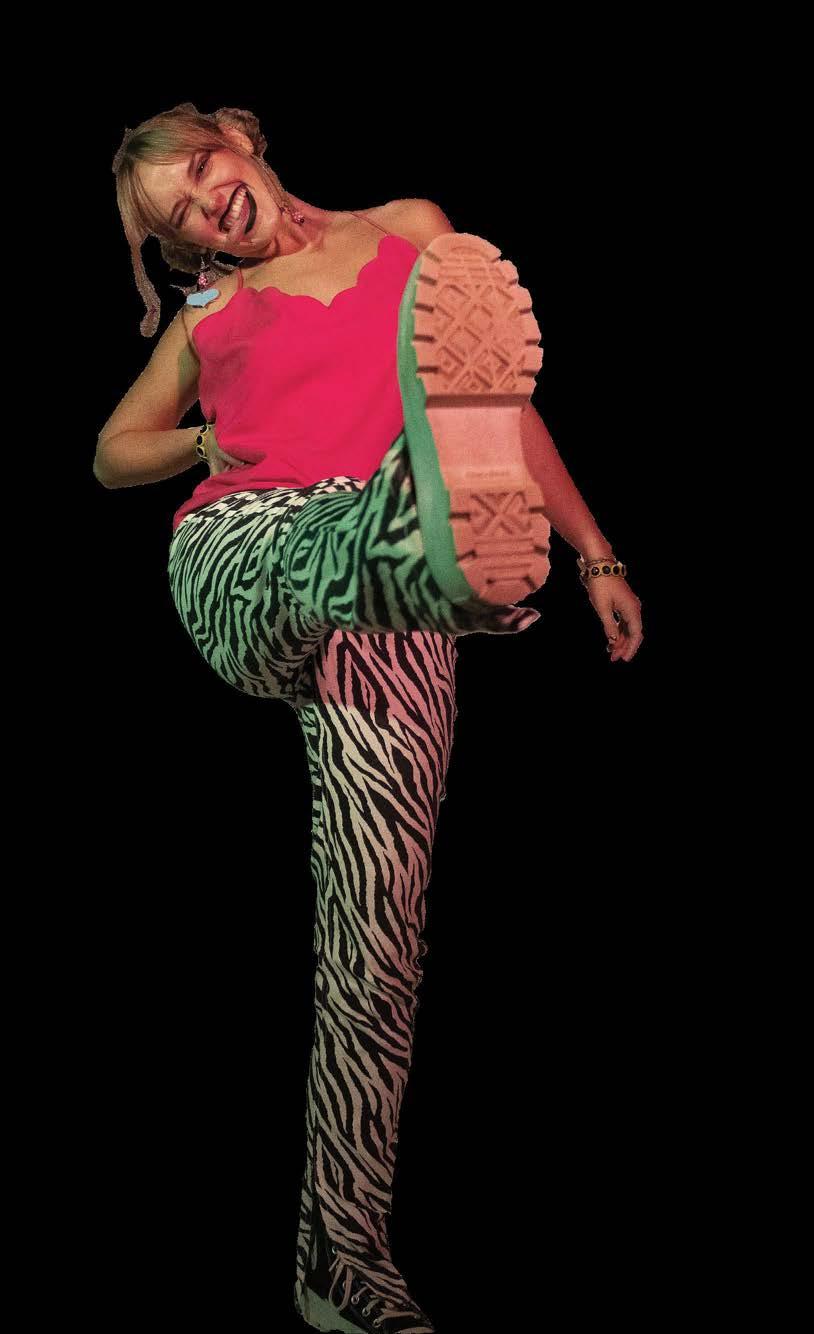



 Pink Scalloped Tank: Sid & Nancy
Pink Scalloped Tank: Sid & Nancy



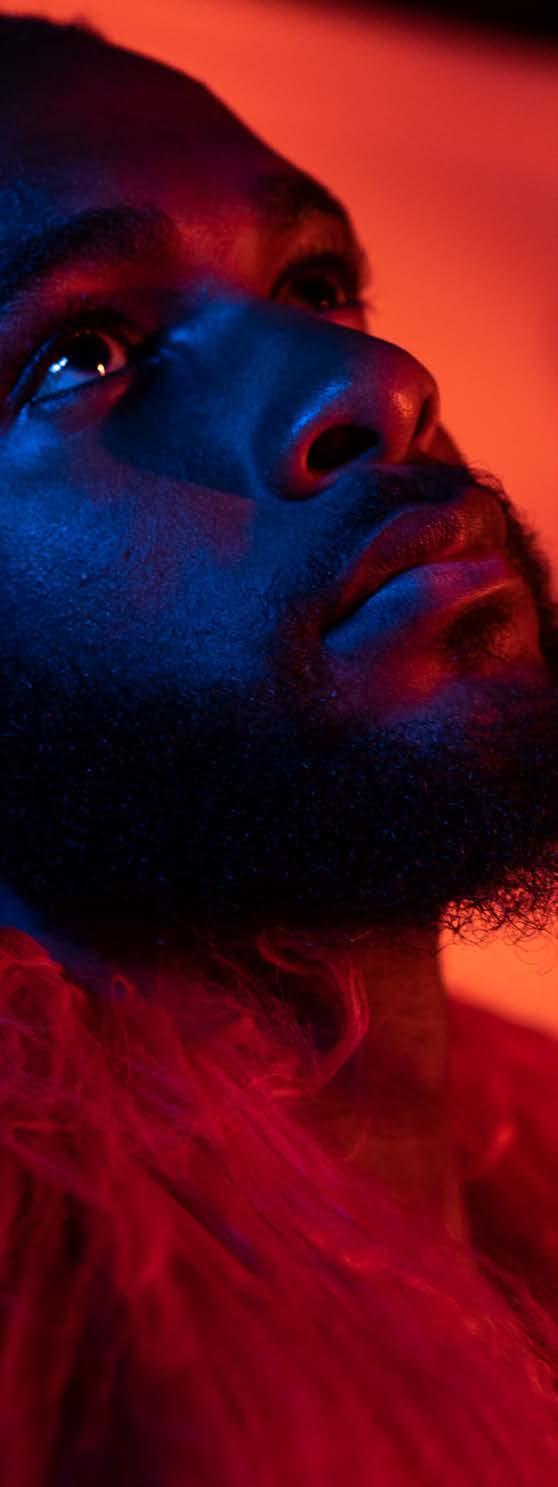

They say, “you can dream beyond the sky,” but what is the limit? When does one remember to stop fantasizing about all the cities and streets they want to walk through? What does one do when those dreams shatter?
BY AHALYA MURALEEDHARAN • DESIGN BY LILY FERGUSONAS VINA ZIGZAGGED THROUGH the cobble-stoned alleyways of Malé, the capital city of the Maldives, she wished to walk across New York’s Fifth Avenue with yellow taxis rushing by. As she smelt the savory trace of Maldivian fish curry, she began to instead crave the famous Danish smørrebrød iconically made with rye bread. The more she lived in a mundane routine in a familiar place, Vina selfishly, or reasonably according to her, wanted more excitement.
Her mother would bug her saying, “Doll, you always watch the same old 90’s rom coms.” And Vina had no answer for her because it was her insatiable need to watch New York through the lives of Kathleen Kennedy and Joe Fox in “You’ve Got Mail.”
The train stops on “Ticket on Ride” all the way from Kyiv to Copenhagen were the pinnacle of her dreams. While building each train path during the game, her childish mind also built towers of dreams to visit all of those cities.
She was just someone filled with wanderlust. That was her fancied identity: Vina, “the Wanderer”.
One day, Vina declared to her family with determined eyes, “I will move to New York, København and so many other cities, just wait and watch”.
“Of course, you will, but you have to do well in school to go abroad,” laughed her father, not realizing how much his daughter will take it to heart.
Vina realized that to fulfill her dreams, she needed to succeed in her life. And that’s what she did. She resorted to hanging
pictures of New York downloaded off of Pinterest onto her walls and staring at them while banging her head on the bane of her existence, the math textbook.
You might ask, did she reach at least one city of her dreams?
Oh yea, she did. But it came along with shattered dreams and unrealistic expectations of her imagination.
Vina scanned all of the views from the same porthole next to her seat while trying to memorize her dream that had come true. The pictures of NYC were becoming real in her mind, and that feeling was surreal. The New York skyline rising from the Hudson River came into sight. The skyscrapers sprawled out across the land. The lights reflected from the thousands of windows created a Christmas-like ambiance at night. If it wasn’t August and humid, one might think the holidays came early for New Yorkers.
The first week of life in New York was full of window shopping, eating $1 pizzas, and trying to understand the subway lines which mirrored mazes. However, Vina noticed how her hands started getting clammy while walking to her campus to attend classes. The beauty of the high-rise buildings started fading. The fascination with the bobcat mascot of NYU felt more suffocating than liberating all of a sudden. Walking through the streets dodging people and trying not to spill her coffee became a routine. Hiding the dissatisfaction with her new life from everyone especially her mother became harder and harder. The picture board
filled with pictures of New York felt wrong hanging in her shoebox-like dorm. The urge to remove them and replace them with another city increased day by day.
The routine of her past life in the Maldives was returning unexpectedly to NYC, and it made her want to flee. But, where though? Where could she go after reaching the peak of her dreams?
One evening, the smørrebrøds she wished for as a child brought another plan to her mind, “Oh, maybe Copenhagen will be my next destination”.
Considering how she already had started at NYU, Vina chose to continue working towards her computer science degree there for the time being. The manifestation of the routine was her fear, and regardless of it happening in her dream city, Vina trudged through every day of the university while muttering, “I will leave soon. I will leave soon. I will leave soon”. The four years of university in the smack center of New York City flew by before she even realized it.
And, her luck took her to Copenhagen just as she dreamed.
The day of walking through Strøget came for Vina. The longest shopping street in Europe seemed to stretch endlessly lined with cozy stores on both sides. The round, doughnutlike pastry called vwienerbrød sold in one of the cafes in Copenhagen lived up to the expectations she held. There was a time when she thought the Holidays had come to New York early, but
that day in Copenhagen was Christmas Eve. The beauty of Christmas lights wrapped every building and street in its warm glow. As she exited Strøget, Vina stumbled upon the Christmas market at Kongens Nytorv. One of the stalls caught her eye, they were serving a Danish version of mulled wine famously known as gløgg. Deciding to indulge on her first day in Copenhagen, Vina drank the spicy wine before setting off towards her hotel before it snowed harder.
But, she still didn’t feel satisfied. The beauty of the city during winter was consistent with snow and rain; however, Vina’s heart wasn’t content.
The dream which began while playing “Ticket to Ride” seemed stagnant. Regardless of whether it was NYC or Copenhagen, Vina kept failing to find her happiness anywhere. She only moved forward with her life in search of places she could fall in love with. The disappointment of every place not living up to her dreams and expectations crushed Vina further and further.
Because even in Copenhagen, the feared routine came again. It never seemed
to leave her alone, always chased her from one city to another. Never content. Never satisfied. Never at peace. Always the wanderer.
Vina kept questioning herself, “Where to next? Will my heart never be content?”
Maybe there should be boundaries to how much you dream to make sure they don’t destroy you in the end.
However, Vina dreamt again, but her dream was different.
“This is the final boarding call for Vina Ahmed on flight 580B to Malé, Maldives. Please proceed to gate number 5 at once”, announced the flight staff.
Maybe it was time for Vina to stop wandering and rather live. And, what better place than her hometown?
for our attention, all seemingly negligent or indifferent to the effects they have on us as a population.
flowing, never-ending, like a river that stretches into the ocean.
YOUR EYES STARE
focusing but never really focusing. They glaze over themselves as they become overwhelmed with what they are seeing. Your hands move in slow, predictable movements, enough to keep a steady stream of information flowing from the fountain. Your fingers move swiftly. This is a motion you’ve done thousands of times, a movement so known to you that it isn’t even noticeable. Your brain turns itself off, the senses bombarded with loud sounds and bright flashes of light that dull you until you don’t even remember where you are. And so the spiral continues, the fountain of information flowing and
There always seems to be something happening in our world today. From the moment we wake up until the moment we fall asleep, there is always something vying for our attention. Social media apps that seek to feed you endless amounts of content that keep you scrolling and scrolling for hours. News stations running every hour, every day, telling you of horrific acts happening halfway across the globe. Media companies that want you to binge watch their new show, the gaming industry forcing you to pay money just so you can get the newest look and advertisements being drilled into your head over and over until they’re stuck. We live in a world where we are constantly bombarded with products, services and companies all vying
It’s hypocrytical for me as a writer, someone who works to provide people with content to read and enjoy, to write that there is too much content in the world. It’s hypocritical for me to say that you should read less, watch less and engage less; but there is truth to the narrative that many people are overwhelmed with the information presented to them on a daily basis. I don’t write this to blame anyone for falling into the trap that these industries create. I write this so you, the reader, can be aware of how companies fight for your time so that you can truly make it your time.
The effects social media can have on your mental health are well documented. Dr. Christine Stabler is the vice president of academic affairs and the general director of women’s health at Lancaster General Medicine. She writes that social media can
How companies fight for your attention and how you can resist it.BY MAX BOWMAN • DESIGN BY MEGAN WOOTERS
had enough and turn it off.”
have similar effects as a slot machine. Since you don’t know the content until it is opened, it can create a sense of reward by releasing dopamine. This is most prevalent with TikTok, which has an algorithm exists to serve you endless content. You never know what you’ll get from the next video, and that anticipation, coupled with the release of dopamine when you find a video you enjoy, creates a desire to continue scrolling to continue feeling that dopamine hit. Eventually, your body builds up a dopamine tolerance, requiring more stimuli to receive the same effect as you experienced originally. This creates a loop of needing more engagement, more videos and more scrolling until you get the reward you’re used to. Because of this, Stabler recommends watching out for warning signs of this behavior, including spending more time with social media than with friends or family, noticing declining school work, or deprioritizing self-care practices. Stabler recommends exercise, gatherings, volunteer work or spending time with friends as a good way to curb social media habits and reduce the hold that these apps could have over you.
The effects the news cycle can have on you are much less obvious, although they
work in much the same way. Dr. Logan Jones, a psychologist based in New York, said, “Unfortunately, a lot of the news we consume today isn’t so much reporting as it is a way of keeping people addicted to the news cycle.” Jones states that sensational headlines get more attention, which drives news outlets to often focus on disaster reporting, creating constant negative information for us to engage with. This constant negative content can activate the release of stress hormones like cortisol and adrenaline, and long-term can lead to fatigue, anxiety, depression and sleep deprivation. The response to COVID-19 sweeping through ourcountry, the never-ending information on the war with Ukraine and the inflation nightmare best exemplify the news’ ability to create a fear in us that keeps us watching all day, every day.
To combat this, doctors recommend limiting news and social media to around thirty minutes a day and simply turning the news off once you have gotten any vital information that you might need for safety concerns. UofSC student Bill Frye agrees. “The news is fine in moderation, but people can get overwhelmed easily, and it’s important to understand when you’ve
It is hard to avoid the overwhelming amount of information and sensory overload thrown at you daily. Whether it is social media driving endless scrolling or news outlets reporting sensationalist headlines to keep you engaged, it can often be hard to even realize you are being manipulated into driving their engagement. Now more than ever, it is important to stay informed and up to date with what is going on in the world around us. But that does not mean we are obligated to spend our days scrolling mindlessly through our phones, staring blankly ahead at the news hoping that it’ll tell us something we haven’t heard before.
Instead, take this time to make connections with people you can spend real, meaningful time with. It’s important as well to take the steps to actually make a difference. When the news wants to tell you everything is going wrong, there are places right here on campus where you can help make things better. You are in control of your narrative. You decide what you pay attention to, what you give your time to and what you care about. Make sure you’re paying attention to the right things.
“And so the spiral continues, the fountain of information flowing and neverending,flowing,like a river that stretches into the ocean.”
When life is chaotic, what choice do you have? How do you find peace in uncertainty?
“CHAOTIC” IS ONE OF the many ways a college student might describe their lifestyle. Entering a university brings challenges, from balancing academics and social life to settling into adulthood miles away from home. Not to mention that while we are navigating our way through the campus bubble, the environmental, political, and international climates of the world are in turmoil on the outside.
Crises are always present. These challenges present themselves in new ways every day which lead to overwhelming feelings of uncertainty. But the power of uncertainty in our lives lies in our ability to adapt.
If all of us at G&B were able to predict the future of this semester’s magazine
production, then we would be inflexible and stagnant. A magazine run by students (and only students) is no stranger to chaos regarding deadlines. We try and get ahead of the pandemonium with a rigid calendar, but it’s no match for the unexpected events that drop in our laps and threaten our status quo.
When life is chaotic, what choice do you have? How do you find peace in uncertainty?
We need to fall head over heels into chaos. The heart grows stronger through dealing with minor deviations in its rhythm. So vital is our ability to pave new paths—to learn and to grow—that you could say our lives depend on it
Creative work that represents how UofSC students view their future despite the world falling apart.
WWITH EVERYTHING GOING ON in the world from the recession, mass shootings every other week, Roe vs. Wade overturning, the climate crisis and so much more, it’s hard to see a positive future ahead of us as young people. Here at Garnet & Black, we wanted to provide a space for students to create something from the chaos and uncertainty of the world into something of their own. We asked students around UofSC’s campus to submit creative work based on one of the following prompts: “Amidst the world falling apart around you, how do you feel towards building your future?” or “Despite the world falling apart around you, how do you build your future?”
The objective was to let the artists choose their own perspective; to either reflect on the chaos or show how they’ll rise above it. All of the following artists chose the latter
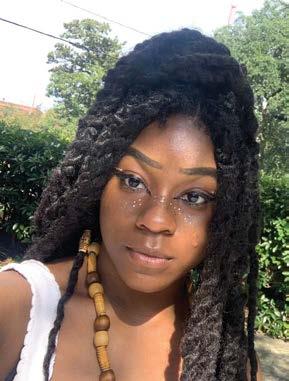
This work was initially made for someone I was extremely close with. However, within our relationship, I was exhausting the possibilities of myself as an individual.
I revisited this work shortly after our conclusion and continued to pour into it. I realized how much I saw myself in it. I came into this world overwhelmed and overrun with anxiety with so many choices and possibilities, as well as my ancestors’ ambitions heavy on my shoulders. They fought themselves out of generational poverty for me to be where I am today and have the luxuries that I have. I was able to rise up because of it. That’s something I’ll never forget. As I look around, especially at a school like UofSC, it’s easy to feel like everyone has had some kind of generational head start, to look around and compare my selfprogression to those around me.
When things don’t go as planned my mind wants to shut down, to rest, but my spirit wants to burn and crash. This work is a physical manifestation of it all. When the world is falling apart around me I remember who I am. I live, I love, I crash, and I burn, over and over again.
My name is Sol and like the sun I rise again.
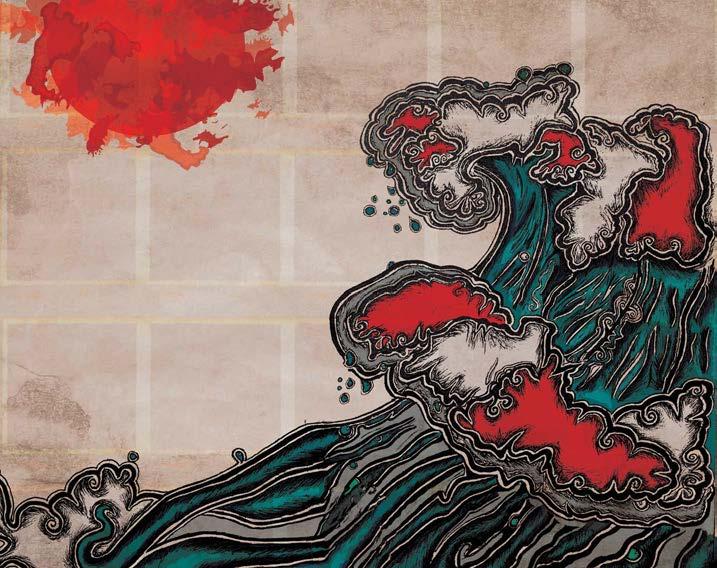
This piece is a mixed media collage highlighting what it feels like to be moving forward. I wanted to capture the feeling of growing and changing with the future, despite the uncertainty of it all. Everyone is focused on negativity and wasting time. This collage shows a change in perspective and a hopeful outlook
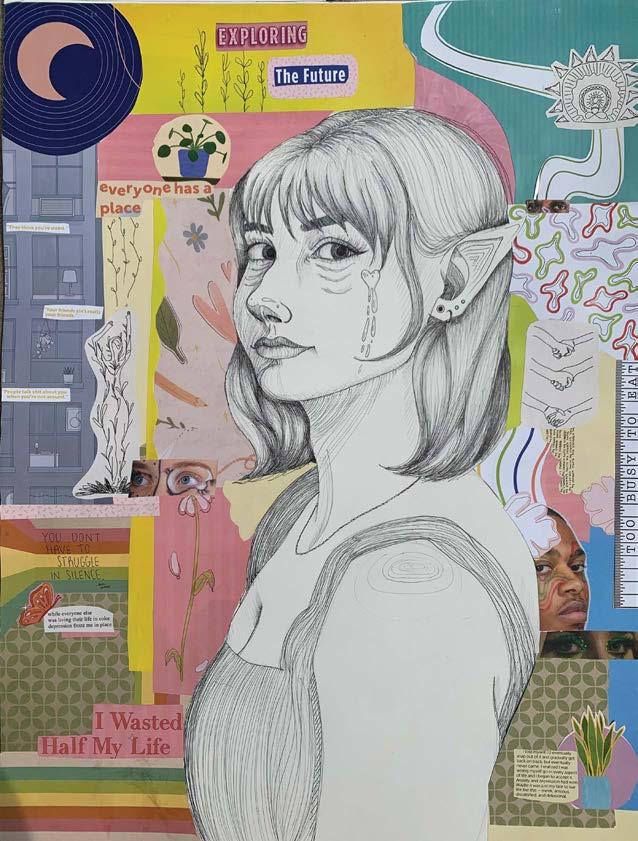

“MIXED
PORTRAIT”-
Mama said that cookies crumble; that’s just the way of the world. Bubbles burst and sandcastles tumble, and sometimes your cards fold.
Mama, that’s hardly where the breaking stopped. Up northward glaciers break off in excruciating cracks, the forests felled, the rivers swelled— Children plunge from fractured families to decaying city blocks, taught to grasp blind for crashing currency (never quite enough). Bodies sown with broken bones, and broken hearts or promises. Temples fall and the holiest of hopes collapse. Cookies have the peaceful crumblings; ideals go in pops of bursting glass.
Mama, remember teaching me that “fall” meant more than just scraped knees? Consider: the dead leaves giving autumn its choice smell. March’s bridal entrance in pink veils of fallen blossoms. Consider: decay means mushroom blooms of white and cracked book spines mean love. How sunrays saw serrated daylight into misty mornings. To that red shade of “broken” and I counter the miraculous multiplied moons in a cracked mirror’s face.
The breaking of dawn and awkward silences, the cracks of eggshells and smiles. A smash hit means you’ve blown up and that’s all good. What of crumble cookies, popped corn, and upside-down cake?
I offer you your own vocabulary: Fall in love, take a crack, break it down, collapse in laughter, crack a smile, break a leg!
Mama, the world cries out that it is falling apart, breaking in two and I’ll do my part to smash all expectations, set hearts aflame, reap dawn light amid shattered glass ceilings. And my favorite thing about this cracked and broken world, this cracked wide open world, are the torn down walls between us.
The world does often seem like it is falling, breaking, or otherwise blowing up. Words are powerful tools; their weight, shape, and purpose should always be carefully considered. This poem is an experiment to suggest that such words—and also our mentalities—need not be apocalyptic. They can also be vessels of optimism and even positive change for the future.
The poem reuses the same set of vocabulary in two opposing sections and combines them again in the last stanza. I chose to break down the structure and rhyme scheme that existed in the poem to mimic the disorientation and confusion many young people are experiencing, and I brought the rhyme and rhythm back at the end to create an optimistic tone and to show the compatibility of realism and hope for the future.


WHEN ONE THINKS OF the college experience, many buzzwords may come to mind: academics, research, roommates, football, Greek life; the list could go on for four years. The American college experience has become iconic to the rest of the world, and a forerunning piece of this iconography is the emphasis placed on social sororities and fraternities. One aspect of university life that sometimes goes unacknowledged is the opportunity to expose oneself to all different kinds of diversity, be it sexual, gender or ethnic. In recent decades, the overlap between American Greek life and cross-cultural awareness has become ever prevalent as students are more conscious of learning to expand their worldviews. The world in which we live is a truly global community, and rich diversity manifests itself vividly on the UofSC campus and at other universities worldwide. The cocktail of perspectives offered by students from all backgrounds enriches every part of Gamecock life. It is and will continue to be a key fixture in Greek life.
So many students in the United States go off to college with the dream of joining a sorority or a fraternity, and this goal is so widely shared that it has become a concept almost synonymous with university life in general. Students may want to pledge to a Greek organization to make new friends, network or learn more about their academic and personal interests. However, some people have found a chapter that offers them the chance to learn more about their cultural identity.
On the UofSC campus, there are five multicultural Greek-lettered sororities and fraternities. These include Alpha Sigma Rho, Delta Phi Omega, Kappa Delta Chi, Pi Alpha Phi and Phi Iota Alpha. While similar to other Greek organizations in that they promote meaningful personal and professional connections, multicultural chapters take their mission a step further. They advocate for the celebration of all cultural identities and for cross-cultural communication and appreciation. This characteristic emphasis on diversity education is the crux of what sets it apart in essence from other lettered organizations.
UofSC is a relatively diverse campus with 27.9% African-American students, 5.3% Hispanic students and 1.5% students of Asian descent. However, the student body is still majority white. Robert John, Vice President of Phi Iota Alpha, believes
that multicultural Greek organizations give minority students a place to find others with similar backgrounds to themselves in the midst of a predominantly white university.
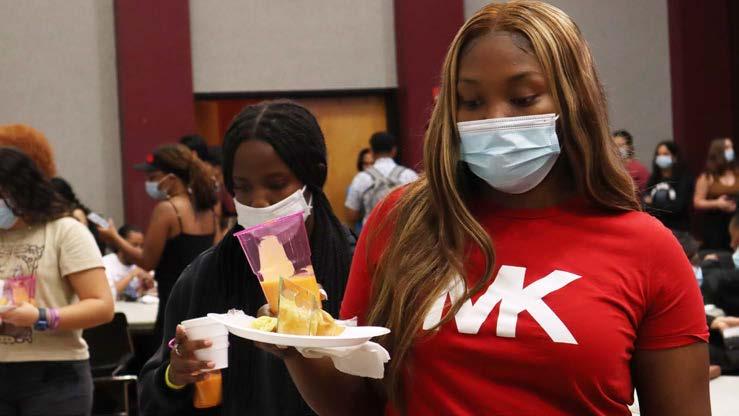
Founded in 1931 and with 82 chapters worldwide, Phi Iota Alpha is the world’s oldest Latino fraternity. While John shared that many chapter brothers join to form friendships and receive professional advice and advancement, there is an additional priceless benefit to choosing a fraternity whose members share similar values and cultural history. The fraternity’s mission is to promote appreciation and preservation of Latin American culture among its members and across the UofSC campus as a whole.
On the Phi Iota Alpha website, it explains that the fraternity does not have any formal founders, but the brothers instead look up to a handful of intrepid men whose bravery contributed to liberating Latin America. One commonly shared story is that of Jose de San Martin, a revolutionary who led a self-trained army across the Andes Mountains and into Santiago, Chile, where they claimed it unopposed by the Spanish. This ode to a proud point in Latin history illustrates one of the main elements of multicultural Greek organizations that differentiate it from other Greek life. Multicultural Greek life fosters an understanding of cultural history and identity among its members and creates a space where members can share in a sense of pride for who they are. John is half Peruvian and Trinidadi, and he said that the unique space cultivated by Phi Iota Alpha has given him an opportunity to learn more about his roots. Multicultural Greek life
allows members to navigate college with people from like ethnic backgrounds, but also promotes awareness to every student on campus through outreach events.
Judith Triama-Beltran is the Vice President of Publicity for the Multicultural Greek Council as well as a member of Kappa Delta Chi. As a first-generation student who wanted to find people who shared her Mexican-American heritage, she said that a university’s diversity quotient played a large role in her college decision process. According to TriamaBeltran, many women join Kappa Delta Chi as a way to connect with ethnic roots that they may not have had the chance to explore earlier in their lives. She sees the chapter as an opportunity to give back to the UofSC campus and to others who share her ethnic background.
“All of us have a national philanthropy and we try to do local philanthropies as well to help out around Columbia. We try to gear it towards the Latin community,” Triama-Beltran said. Kappa Delta Chi holds an event in the spring to raise money for the American Cancer Society because studies have shown that Latin women are more susceptible to breast cancer. Lately, Kappa Delta Chi has been looking to partner with other chapters to raise funds for those affected by Hurricane Fiona. “Whatever we see if affecting the Latin community, we try to fundraiser and get on it.” Additionally, Triama-Beltran said that her sorority has been focusing efforts on establishing a program that will offer scholarships for Latin students or firstgeneration students who are interested in pursuing higher education.
All of the multicultural Greek
learning to be more open-minded, and being able to learn how to approach a person who’s different from you.”
said. With so many current and upcoming events sponsored by the council, visibility for these organizations is increasing. While these events are a great way to learn more about different multicultural sororities and fraternities, there is also information available through resources such as Garnet Gate, “It’s important for people to know that we’re here.”
portant part of the Multicultural Greek Council’s mission.
“We are relatively new. We started off as a board in 2014, and officially as a council in 2015, so it’s been seven years.”
With so many current and upcoming events sponsored by the council, visibility for these organizations is increasing. While these events are a great way to learn more about different multicultural sororities and fraternities, there is also information available through resources such as Garnet Gate. “It’s important for people to know that we’re here.”
organizations hold numerous events on campus every year to give students an opportunity to be exposed to the chapters’ unique respective cultures. On September 27, 2022, Kappa Delta Chi and Delta Phi Omega held their Taste of Culture event, where students could come to learn more about Latin American and South Asian cultures and enjoy a plethora of different foods representing different parts of the world. John also talked about the kinds of outreach activities his fraternity holds throughout the year. “With my fraternity, Phi Iota Alpha, we do a march,” he said. “As well as KDChi, they do strolls to Hispanic songs. It’s really cool to watch at our showcase.” This event has a special significance to the Phi Iota Alpha members as it’s a way for them to commemorate the story of Jose de San Martin and share those same feelings of pride with other students on campus. Chapters also take part in monthly Multicultural Mondays on Greene St. which are great opportunities for students to drop in and learn more about the diverse offerings on campus with a DJ spinning world music in the background. These kinds of outreach events play a crucial role in promoting cultural celebration on campus, and multicultural Greek organizations see this as a vital part of their mission. “We like giving a piece of us to campus so that we can share our love for our culture.”
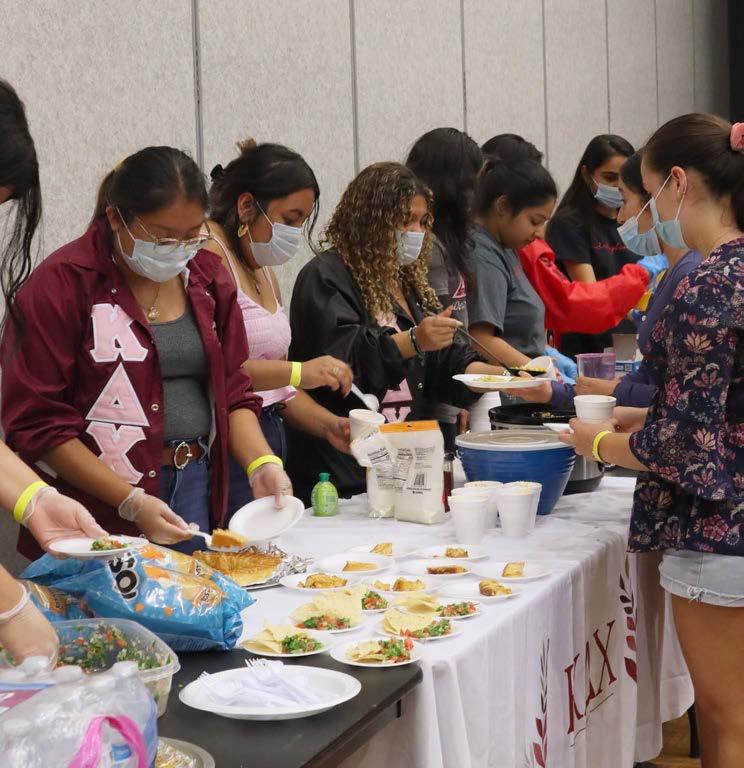
Every Greek organization has a priceless value in the lives of its members, and many graduates and current students will say that they met some of their closest friends in Greek life. In addition, there is something to be said for the depth of bond created when you share a distinctive sense of identity with the members of your chapter. Friendships are fortified by a passion for preserving cultural history that transcends into a web of deeply personal connections that all students long to find. For Robert, Judith and all who are involved in a multicultural organization on campus, these letters signify a sense of pride, community and belonging that strengthen bonds of fellowship in beautiful and unprecedented ways. As Judith said, “It’s never too late to learn about your culture.”
John implores that anyone with a deep desire to learn about a certain culture should find a way to become involved in multicultural organizations. He noted that this emphasis on cultural awareness and preservation is one thing that sets his and other multicultural chapters apart from others, “We’re aiming for people who are interested in learning about the culture,
Within Phi Iota Alpha alone, John said that he has a graduated fraternity brother from Pakistan and another from the Middle East, even though Phi Iota Alpha is a Latino fraternity on paper. He added that members from all backgrounds are not just welcomed but also encouraged to get involved. “Especially at a school that’s growing more diverse demographic-wise, or if you want to go to a bigger city, it’s good to have that cultural awareness and sensitivity in who you’re talking to.” It is clear that multicultural Greek organizations offer a safe and receptive place for those searching for others with a similar background, but they also play a vital role in promoting cultural understanding to everyone on campus, regardless of their ethnicity.
With many of these organizations still being somewhat unknown to many students, Triama-Beltran sees campus outreach as an important part of the Multicultural Greek Council’s mission. “We are relatively new. We started off as a board in 2014, and officially as a council in 2015, so it’s been seven years,” she
Every Greek organization has a priceless value in the lives of its members, and many graduates and current students will say that they met some of their closest friends in Greek life. In addition, there is something to be said about the depth of the bond created when you share a distinctive sense of identity with the members of your chapter. Friendships are fortified by a passion for preserving cultural history that transcends into a web of deeply personal connections all students long to find. For John, Triama-Beltran and all who are involved in a multicultural organization on campus, these letters signify a sense of pride, community and belonging that strengthen bonds of fellowship in beautiful and unprecedented ways. As TriamaBeltran said, “It’s never too late to learn about your culture.”
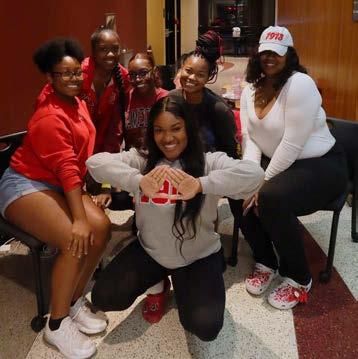

UofSC is full of all kinds of clubs, but what are the niche ones like?

ATTENDING A COLLEGE with 24,000 students has its perks (cue giant stadium games and various career opportunities), but trying to find a way to make a big school smaller leads to drowning in interest meetings and thousands of club flyers. On top of that, how do you find ones that match your interests? While broader, more recognizable organizations exist on campus, such as Student Government or Mountaineering Club, so do smaller, more niche clubs.
Balanced Beauty president and founder, Anari Price, found that the best way for her to get involved with something that she was passionate about was by creating it.
“I founded this club back in September of 2020,” Price said. “The club is a minority skincare, wellness and mental health organization. We pretty much just want to create another safe space for minority men and women to be able to tackle and deal with their insecurities.”
Being on campus with other minority-focused organizations was what inspired Price, but none of these groups seemed to tackle the skincare and wellness area that she found herself drawn to.
“I noticed we didn’t have a skincare aspect of a club here — we have Collegiate Courage that focuses on natural hair — so I really wanted to bring something new that we all could relate to,” Price said.
Balanced Beauty’s meetings cover all different topics involving skincare, mental health and personal wellness. One that stood out to Price was when members experimented to find their skincare routine.
“We all did an experiment where we
cleaned our faces off with wipes and tried different natural products, like yogurts and different things, and watched to see how our skin reacted. From there we found out our skin types,” Price said. The club’s dynamic
is extremely close, with all members comfortable enough to open up and speak about different issues involving mental health or wellness. Also, by being a minority-based club, they are able to connect to one another in even deeper ways. Spaces like these are integral to campus to ensure that all students at UofSC have a sense of community. Price came in with an idea, and eyes on the prize for finding a close-knit community for her to pour her heart into.
“Freshman year, I came in determined, as a first-generation student, to get involved as much as I could and make my impact at this huge campus and leave my legacy,” Price said.
Neha Arunprakash, founder of the UofSC Bharatanatyam Dance Club, also wanted to create an organization she was passionate about.

“Natyam is a short form for Bharatanatyam, which is a classical dance from Southern India. They used to dance it in temples, and they teach students and kids the stories of Hindu culture. Now it’s more modernized and you can dance to any kind of music, but it’s usually mixed or pure classical,” Arunprakash said.
“I learned for 12 years, since I was eight or nine, and I graduated last year… I had an idea when I came [to UofSC] but I started the process of creating the club in January of 2022. I finally got it confirmed and approved by March of 2022,” Arunprakash said. While other schools in surrounding states have a competitive team, Natayam Club is not competitive.
“A lot of these students who learn Bharatanatyam, it’s a whole process that takes about five to twelve years,”
Arunprakash said. “It’s basically like school but for dance, and you have to graduate from it to be a Bharatanatyam student.”





















Natyam Club is full of people who have been taking Bharatanatyam for years, and others who have never done it before.
Mondays are dedicated to learning the dance, while Wednesday practices are rehearsal days. Arunprakash spent her summer choreographing the dances for the club to learn this year. “We’re working towards a showcase right now, so we have a total of eight dances to complete,”
Arunprakash said.
Creating dances is rewarding, but Arunprakash finds that club members adding their own parts to the choreography makes it fun and interactive, and is a great way for them to grow as a team.
“Our special dance is a folk dance,” Arunprakash said. “For me, I don’t like to be constricted and controlled, so I gave the girls an opportunity to just come up with choreo. That gave them joy because everyone got to put something into it.”
Two other club presidents, however, found an environment where they thrived in a club already established at UofSC. Justin Land of the Jiu Jitsu and Judo Club came in with little experience, but is now the president.
“I got into jiu-jitsu specifically when I got on campus. I just joined the club the beginning of last year, so that was the first time I had done jiu-jitsu itself,” Land said. “My first job through high school was actually as a trainer at a kickboxing gym, so I’ve done some martial arts stuff, but finding the club was the first time I had actually done jiu-jitsu.”
Land’s job as president involves











administrative duties, such as planning, leading practices and bringing in instructors.

“Most of the time, we have our instructors come in and we’ll lead some sort of warm-up. Then we’ll do line drills for things that are more jiu-jitsu specific, so we’ll practice different rolls and a break fall, and some other various movements we do a lot. Then once we’ve done that, we’ll turn it over to the instructors and we’ll drill whatever techniques they have planned for the day,” Land said.
The last 30 minutes of practice at the club are used for ‘live rolling’ or sparring using what they had just learned. The club itself is tight-knit, consisting of somewhere around 30 members.
“[The environment] is really relaxed and laid back. We’ll joke and crack up the whole time. It’s a lot of fun, and everybody gets to know each other. It’s kind of rude to choke somebody out without asking their name first,” Land said.
Another club president, Maxwell Stuckey of the Nippon Anime Society of Heavenly Imagery Club, more commonly known as NASHI, found a way to make campus smaller with his interest in anime.

“Club goes for three hours… Mainly, we watch anime, and we vote on what to watch every month, and every so often we have special events. We have a flea market day where we will bring in our anime merchandise and sell it. Pretty much every meeting, for anyone who doesn’t want to stay and watch, we have a game room where everyone hangs out and plays tons of video games,” Stuckey said.
Stuckey joined the club after transferring last year, and the connections he made
kept him coming back.
“I transferred from Savannah College of Arts and Design [SCAD] last year and I had heard there was an anime club, so I just went to [a meeting] and instantly made friends,” Stuckey said. “I was super reserved when I first went there because it was a new school, but I found several best friends—one of whom is my roommate now.”
NASHI is different from other clubs in a few ways, but one of them that stands out is the laid-back aspect that members enjoy.
“[The dynamic] is different—we’re a casual club, so we don’t require people to come a certain amount of times, people can just kind of come and go,” Stuckey said. “A lot of us who come more often, are tighter with each other and know each other better,” Stuckey said.
Stuckey found NASHI as his place to open up and find people with similar interests as him—it was a way to make a big school smaller.
“It helped me get out of my shell a little bit. I wanted to do that for someone else,” Stuckey said, “And I’m glad I did it.”
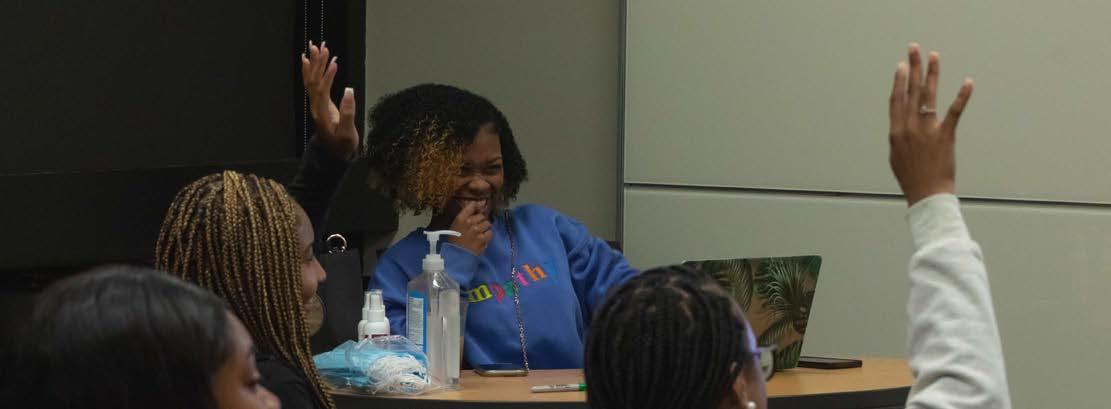
























there are silver spoons that frame ceramic plates. there are turmeric-stained fingernails surrounding glass bowls. “Please get the water.” at my indian table, there is aloo sabzi with cumin seeds nestled between the pieces, reminiscent of my peers who called them “bugs” at the lunch table. at my indian table, it smells like coriander and garam masala, there are crisp rotis with creamy dahi“Remember the kheera.” there is paneer, bhindi and rajma chawal.




“I don’t like rajma.” at my indian table, there is not an overbearing, marriage-crazed mother, though the media begs to differ. she is kind and judgemental and clever and truly does not care about my love life. at my indian table, there is not a stoic, quiet father. he is full of article quotes and puns and explains how to invest in stocks.












“What is your GPA?” at my indian table, sometimes there is silence, so we can listen to the echoes of an argument from last night. i don’t know hindi, “How could you?” but i can understand discontent. at my indian table, sometimes there is laughter that is so loud we cannot hear our own thoughts
 BY RAEVA BALI • DESIGNBYMEGANWOOTERS
BY RAEVA BALI • DESIGNBYMEGANWOOTERS



“There is value in gossip!” at my indian table, i fold my aloo into my roti, “That’s not traditional.” i do not always respect my elders “Respect is earned.” and i eat my food with my hands. i eat my food with my hands.














































The trend cycle is one of the most predictable yet mysterious phenomena in the world. Each September, stylists, editors, influencers, retailers, models and more gather in all the major fashion cities to watch top-tier designers showcase their newest collections. From the runway, these trends trickle down through the pyramid of fashion individuals until they circle back approximately 20 years later. Every fashion trend has been strategically forecasted one to five years prior. Thus, based on research, we can confidently say these 10 trends are going to be everywhere this fall.
Neon PalettesWhile fall fashion typically draws color inspiration from the burnt oranges and dark greens of the changing leaves, we are bringing the color back to the streets this season. The Pantone color palette from New York Fashion Week, which took place in Sept. 2022, included fierce and fiery neons such as empire yellow, tangelo and classic green, to name a few. Shop this trend now because we guarantee it will stay for the warmer months too.
L.L. Bean Boat and ToteThis trend is too good to not be included. You may have seen this ironic trend floating around your Tik Tok “for you page.” It gives unhinged party girl meets sophisticated summer in the Hamptons. Coined by Grace Wiener of @ironicboatandtote on Instagram, influencers are getting the classic Boat and Tote from L.L. Bean personalized with sayings such as “emotional baggage,” “psycho,” or “Birkin,” a play on the elusive, iconic, and not to mention, extremely expensive bag from Hermes.
Maxi HemlinesWhat goes up must come down, so it is no surprise that hemlines are starting to hit the floor again after the re-emergence of the mini skirt. A perfect example of this trend is the almost always sold-out Soft Lounge Long Slip Dress from Skims, the lounge and intimate clothing brand by Kim Kardashian. Another influencer loving this trend is Emma Chamberlain who has mentioned that her summer uniform consists of a long skirt and a tank top. To take this summer ensemble from one season to the next, switch out the tank top for a simple long-sleeve or chunky knit.
Stockholm-InspiredWe can thank the infamous fashion and hair influencer, Matilda Djerf, for this trend this season. Stockholm style consists of monochromatic looks with a fashionable European flare to create something so effortlessly chic. Think oversized cashmere sweaters, basic cotton shirts and low-rise trousers. Shop these simple staples that can stay in your closet forever and transport you to the streets of Stockholm when you pair them together
5 4
Professional CoreTwo years in a pandemic means two years without the need for a business professional wardrobe, but do not worry because the fashion industry is about to make up for lost time. Celebrities and influencers alike have been seen unironically sporting professional wear as street style. Throw on a pair of trousers and a blazer (bonus points if it is oversized), and people will be mistaking you for Hailey Bieber
Cargo BottomsSeen on celebrities like Bella Hadid and Dua Lipa, cargo pants and skirts have been on the slow rise for a few seasons now, and we expect them to blow up this fall. From Five Points to the frat lots to front row in your Econ class, this effortlessly cool utilitarian trend will be everywhere come November.
7 6
Basic White Tank TopYes, something that is most likely already in your wardrobe can be a fashion trend. White tank tops are most definitely in. Pair it with some low-rise jeans or oversized cargo pants, and you will look like you came straight off the runway. This trend is giving off the ‘90s minimalist aesthetic, and we are here for it.
Whether you shop at Goodwill or Gucci, this trend is soon to be in every store. With minimalism being an aesthetic at the forefront of the fashion industry, it is time for bold accessories to shine. Imagine sporty chic meets futuristic fashion icon.
Sporty Shades
10 9 8
All Things LeatherLeather may have been a hot trend last fall, but we are confident it will be back at the top of all trend lists this season too. Whether it be a leather corset, blazer or a sick pair of pants, these statement pieces are bold, edgy and sophisticated for day or night.
Western BootsCowboy boots are leaving the ranch this season and coming to cities near you. Throw them on with a dress, an oversized sweater or a cute pair of jean shorts to add a fun touch to every outfit. These western boots are the shoes of the season.
This industrial utilitarian inspired streetwear aesthetic utilizes neutrals, black and white, and metallic accents to showcase urban fashion. This style focuses on accessorizing with industrial gear, such as combat boots and utility belts, to emphasize the aesthetic of useful fashion.
 STYLED BY LAUREN COLE • PHOTOS BY AARON FALLS AND ALYSSA BLADZIK • DESIGN BY MELISSA BORGERDING
MODELED BY KATIE WALTER AND KATT WYANDT
STYLED BY LAUREN COLE • PHOTOS BY AARON FALLS AND ALYSSA BLADZIK • DESIGN BY MELISSA BORGERDING
MODELED BY KATIE WALTER AND KATT WYANDT
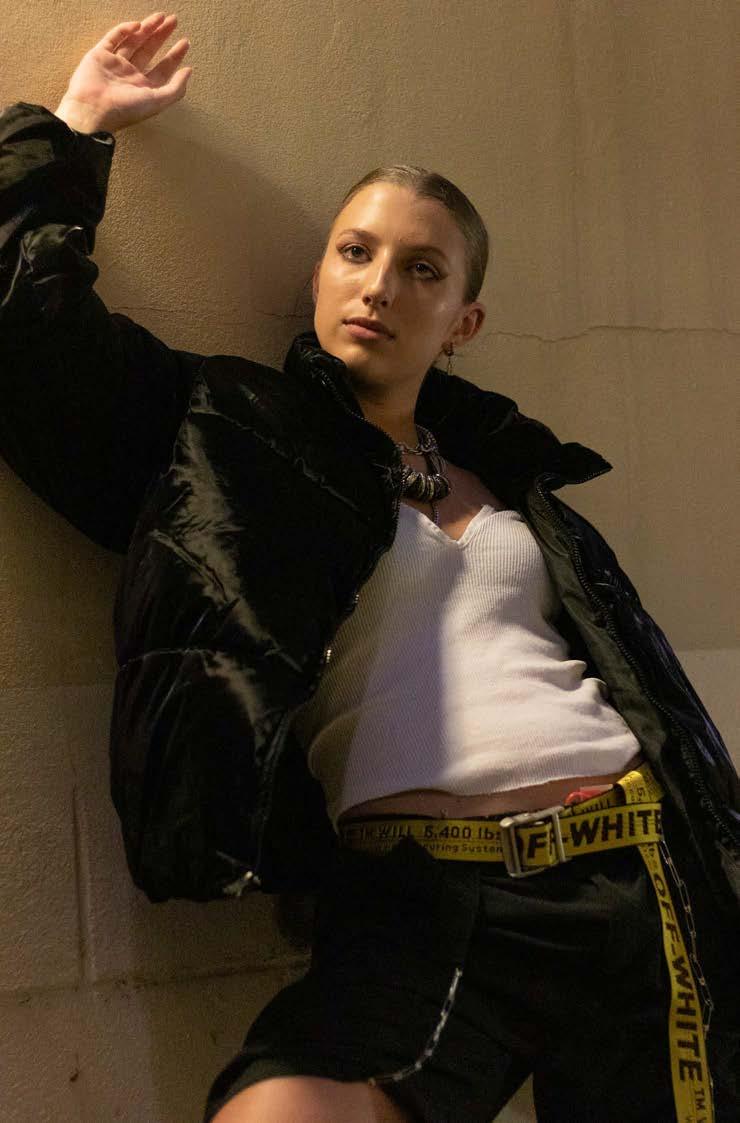
 Off-White Classic Industrial Belt: Revente Sunglasses from: Revente
Off-White Classic Industrial Belt: Revente Sunglasses from: Revente




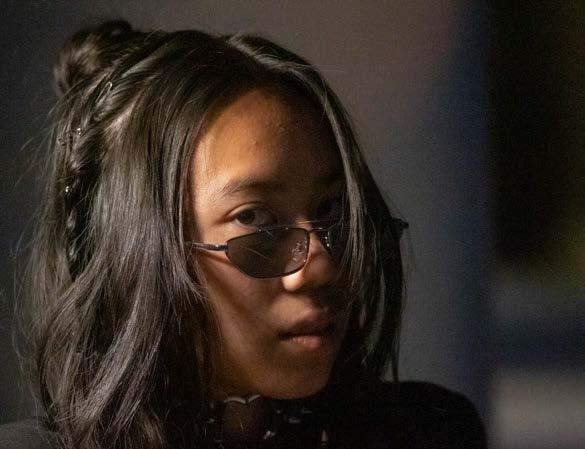


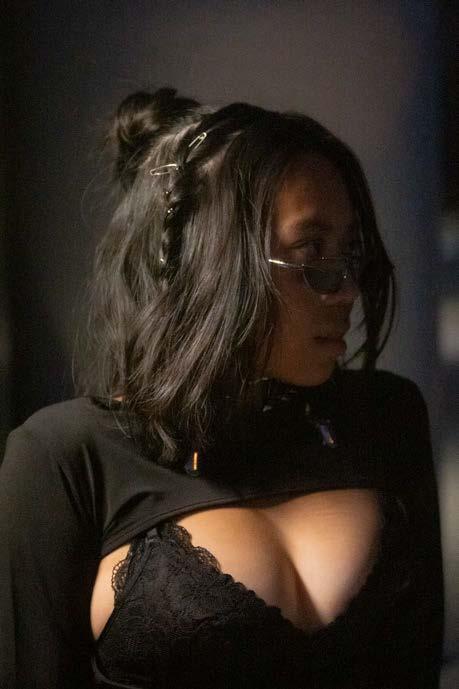




THE STAFF AT Garnet & Black had a cocktail party where each section brought a type of cocktail to be voted on as best overall.
Without further ado, give it up for the winner...

Brought to you by the design team.
Recipe:
-1 part piña colada mix
-1 part Malibu rum (substitute for pineapple juice to make a mocktail!)
-1 part orange juice
Combine ingredients in a shaker and shake until combined. pour into a glass with ice and garnish with a slice of pineapple, then enjoy!
DESIGN BY LILY FERGUSONCraving sushi at midnight? Look no further, here are some easy sushi recipes for college students!
BY AHALYA MURALEEDHARANHave you been giving in to your craving for sushi right after class? Are your meal plan dollars being drained because of sushi? Fear not: there’s a solution.
To avoid spending all of your meal plan dollars on packaged sushi, maybe it’s time for a few college-student-friendly sushi recipes. Before starting to recreate these recipes, do remember to buy a bamboo mat. If you can’t find it in stores nearby, just Amazon it to your mailbox.
When we think about sushi, the first image that pops up is the seaweed wrapped around sushi rice and imitation crab. Hence, we must start off with the iconic and delicious spicy crab rolls.
Ingredients
- 2 cups of cooked sushi rice
- ¼ cup of seasoned rice vinegar
- 4 half sheets of Nori (seaweed sheets)
- 4 sticks of shredded imitation crab

- ½ cup of spicy mayo
- 1 small sliced cucumber
- Optional: sesame seeds
* To make spicy mayo, you can mix 2 tbsp of mayo and 2 tsp of sriracha hot sauce.
1. Mix the rice vinegar and the sushi rice together
2. Place a half sheet of nori on a bamboo rolling mat with the rough side up.
3. Mix the shredded imitation crab meat with spicy mayo sauce
4. After the rice has cooled, cover the nori with about ¾ cup of rice evenly.
5. Flip the nori, and spread the imitation crab mixture over the middle section.
6. While rolling the bamboo mat, press the rice and spicy mixture together.
7. Cut each roll into eight pieces.
8. Garnish the sushi with more spicy mayo sauce, sesame seeds, and sliced cucumber.
After the extremely well-known and pretty mainstream Spicy Crab recipe, a less popular recipe and is the New York Roll. This recipe is for everyone who dislikes the taste of imitation crab because its protein focus is shrimp. Enjoy!
We will be repeating the recipe for the spicy crab roll with just a different filling and slight variations.

Ingredients
- 2 cups of cooked sushi rice
- ¼ cup of seasoned rice vinegar
- 4 half sheets of Nori (seaweed sheets)
- 1 pound of medium shrimp
- ½ cup of spicy mayo
- 1 small sliced cucumber
- Salt & pepper
- Olive oil
Directions
1. Cook the shrimp on a pan for two minutes per side with olive oil and a bit of salt & pepper.
2. Mix the cooked rice with rice vinegar.
3. Repeat the same procedure to make the roll mentioned above.
4. Flip the nori, and add 5 pieces of shrimp over the middle of the nori.
5. While rolling the bamboo mat, press the rice and mixture together.
6. Each roll needs to be cut into eight pieces.
7. Garnish the sushi with more spicy mayo sauce along with avocado and cucumber.
For those of you who don’t eat meat, there are easy veggie rolls for the vegan audience. Repeat the same directions as the recipes above, but change the ingredients accordingly.
- 2 cups of cooked sushi rice
- ¼ cup of seasoned rice vinegar
- 4 half sheets of Nori (seaweed sheets)
- 4 slices of avocado
- 4 sticks of cucumber
- 4 sticks of mango
I know how much of a hassle making these recipes sound. You have to buy the bamboo mat and the rest of the ingredients. But, a simple home-cooked meal can be more filling and satisfying than the packaged sushi found at the grocery store. Consider turning cooking sushi into a social event, call it “sushi night,” and have some fun with friends.
PHOTO BY SYDNEY BONAPARTE DESIGN BY LILY FERGUSON“I’m just trying to say, if you give my blunt to anyone, they will, like, faint on sight.”
“My name is Tyler, but you can call me Daddy.”
“She’s left early every time we go out.”
“Maybe she’s tired.”
“Maybe she’s stupid.”
“You’re not a raging asshole; you’re a calm collector.”
“Sometimes I want to be fake on BeReal.”
“Do you think a stripper pole would fit in Green Quad?”
“I’m going to the doctor to sell my eggs because I need money.”
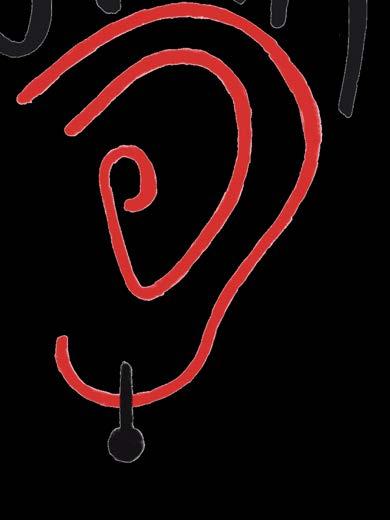
“She craves him every time she has a sip of alcohol.”
“Do you ever want to get hit by lightning? Just to feel something?”
“Live, Laugh, Love, Furries.”
“Listen, you can call out pillow princesses all you want.”
“I have to sell my stocks tomorrow so I have money to pay my rent.”
“I love mustard, I’ll drink it from a glass.”
Scan this QR code to see some crazy student confessions!



